El mercado de la moda y los accesorios en Polonia ha sido testigo de un crecimiento y cambios significativos a lo largo de los años, lo que refleja la evolución de las preferencias y estilos de vida de sus consumidores. Este mercado abarca varios segmentos, que incluyen ropa, calzado, artículos de cuero, joyería y más. Como una de las industrias clave en Polonia, desempeña un papel vital en la economía y la expresión cultural del país.
En este informe profundizaremos en las tendencias y novedades del mercado de moda y accesorios en Polonia, centrándonos en diferentes aspectos como la producción, el comercio, el comercio minorista, el comportamiento del consumidor y el impacto de factores externos como la pandemia de COVID-19. Al analizar datos de diversas fuentes, nuestro objetivo es proporcionar una descripción general completa del estado actual de la industria, el potencial de crecimiento y las oportunidades emergentes.
01. Información general
El informe comienza con una visión general del mercado de la moda y los accesorios en Polonia, explorando estadísticas clave relacionadas con el número de empresas y empleados en el sector manufacturero. Observamos fluctuaciones en el número de empresas y de trabajadores, influenciadas por factores tanto internos como externos.
También profundizamos en los volúmenes y valores de producción de prendas de vestir y calzado, brindando información sobre la contribución de la industria a la economía. Además, analizamos el valor y el crecimiento del mercado, considerando el impacto de la pandemia de COVID-19 en los patrones de gasto de los consumidores.
Número de empresas en la industria de confección de prendas de vestir en Polonia de 2009 a 2020
Polonia: número de fabricantes de prendas de vestir 2009-2020
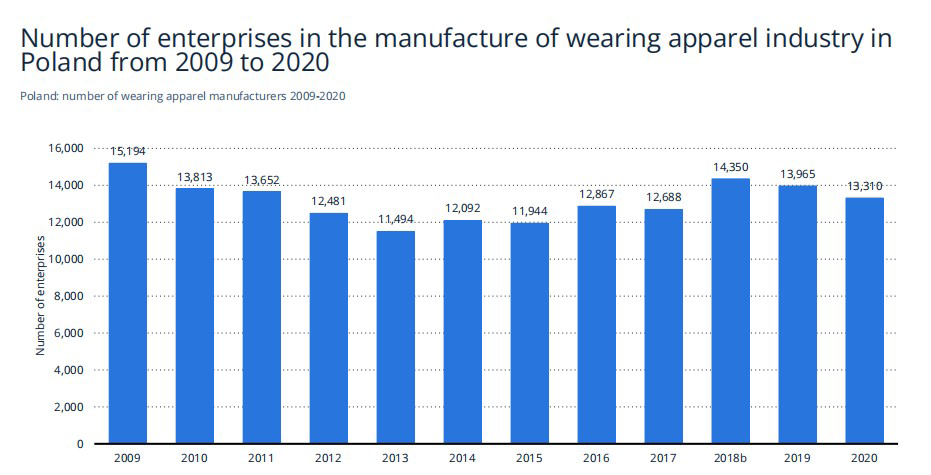
Descripción: El número de empresas en la industria de confección de prendas de vestir en Polonia disminuyó a 13.310 empresas respecto al año anterior. Sin embargo, los dos últimos años en esta industria registraron un número significativamente mayor de empresas que los años anteriores.
Número de empresas de fabricación de calzado en Polonia de 2010 a 2020
Polonia: número de fabricantes de calzado 2010-2020
 Descripción: El número de empresas en la industria de fabricación de calzado en Polonia disminuyó a 1.472 empresas respecto al año anterior. Esto marca el número más bajo de empresas en esta industria durante el período observado.
Descripción: El número de empresas en la industria de fabricación de calzado en Polonia disminuyó a 1.472 empresas respecto al año anterior. Esto marca el número más bajo de empresas en esta industria durante el período observado.
Número total de empleados en el sector de confección de prendas de vestir en Polonia de 2008 a 2020
Polonia: empleados en el sector de confección de prendas de vestir 2008-2020
 Descripción: El número de empleados en la industria de confección en Polonia se redujo en 2020 a 69.678 empleados. En 2020, el número de empleados alcanzó su valor más bajo de los últimos años.
Descripción: El número de empleados en la industria de confección en Polonia se redujo en 2020 a 69.678 empleados. En 2020, el número de empleados alcanzó su valor más bajo de los últimos años.
Número total de empleados en el sector de fabricación de calzado en Polonia de 2009 a 2020
Número de empleados en el sector de fabricación de calzado 2009-2020
 Descripción: El número de empleados en la industria de fabricación de calzado en Polonia disminuyó en 2020 en 3.146 empleados (-18,18 por ciento) en comparación con el año anterior. Esto marca el número más bajo de empleados en esta industria durante el período observado.
Descripción: El número de empleados en la industria de fabricación de calzado en Polonia disminuyó en 2020 en 3.146 empleados (-18,18 por ciento) en comparación con el año anterior. Esto marca el número más bajo de empleados en esta industria durante el período observado.
período.
Producción de ropa en Polonia de 2020 a 2022 (en miles de unidades)
Volumen de producción de prendas de vestir en Polonia 2020-2022
 Descripción: En 2022 se produjeron en Polonia más de 2,1 millones de unidades de pantalones, monos, calzones y pantalones cortos para hombres y niños. Se trata de 1.201 mil unidades más que la producción de pantalones, monos, calzones y shorts para mujeres.
Descripción: En 2022 se produjeron en Polonia más de 2,1 millones de unidades de pantalones, monos, calzones y pantalones cortos para hombres y niños. Se trata de 1.201 mil unidades más que la producción de pantalones, monos, calzones y shorts para mujeres.
Valor de la producción de la industria de confección de prendas de vestir en Polonia de 2009 a 2020 (en millones de euros)
Valor de producción de la confección de prendas de vestir en Polonia 2009-2020
 Descripción: En 2020, el valor de la producción de la industria de confección en Polonia se mantuvo prácticamente sin cambios en alrededor de 2.300 millones de euros.
Descripción: En 2020, el valor de la producción de la industria de confección en Polonia se mantuvo prácticamente sin cambios en alrededor de 2.300 millones de euros.
Volumen de producción de calzado en Polonia de 2017 a 2022 (en miles de pares)
Volumen de producción de calzado en Polonia 2017-2022
 Descripción: En 2022 se produjeron en Polonia casi 20,5 millones de pares de zapatos, lo que representó una disminución de más del cinco por ciento en comparación con el año anterior.
Descripción: En 2022 se produjeron en Polonia casi 20,5 millones de pares de zapatos, lo que representó una disminución de más del cinco por ciento en comparación con el año anterior.
Volumen de producción de cuero* en Polonia de 2017 a 2022 (en toneladas métricas)
Volumen de producción de cuero en Polonia 2017-2022
 Descripción: El volumen de cuero producido en Polonia disminuyó durante el período analizado. En 2022 se produjeron cerca de 5,7 mil toneladas métricas de cuero.
Descripción: El volumen de cuero producido en Polonia disminuyó durante el período analizado. En 2022 se produjeron cerca de 5,7 mil toneladas métricas de cuero.
Valor y crecimiento del mercado de ropa y calzado en Polonia de 2015 a 2021 (en miles de millones de zlotys)
Valor de mercado de la ropa. & calzado en Polonia 2015-2021
 Descripción: Entre 2015 y 2019, el valor de mercado de la ropa y el calzado ha aumentado de manera constante. Se estima que el mercado caerá un 16,3 por ciento en 2020 debido a la pandemia de COVID-19. Sin embargo, en 2021 se prevé que aumente hasta los 37,6 mil millones de zloty.
Descripción: Entre 2015 y 2019, el valor de mercado de la ropa y el calzado ha aumentado de manera constante. Se estima que el mercado caerá un 16,3 por ciento en 2020 debido a la pandemia de COVID-19. Sin embargo, en 2021 se prevé que aumente hasta los 37,6 mil millones de zloty.
Resultado financiero neto del sector de confección de prendas de vestir en Polonia de 2017 a 2022 (en millones de zlotys)
Resultado financiero neto del sector de la confección en Polonia 2017-2022
 Descripción: Los resultados financieros netos del sector de la confección aumentaron en Polonia en el período observado un 15,1 por ciento. En 2022, ascendió a más de 309 millones de PLN.
Descripción: Los resultados financieros netos del sector de la confección aumentaron en Polonia en el período observado un 15,1 por ciento. En 2022, ascendió a más de 309 millones de PLN.
02 Comercio
La sección de comercio se centra en la dinámica de importación y exportación de prendas de vestir, calzado y productos relacionados. Destacamos proveedores y destinos líderes, arrojando luz sobre las conexiones comerciales globales de Polonia en la industria de la moda.
Importaciones y exportaciones de prendas y complementos de vestir en Polonia desde 2017 hasta 2021 (en millones de euros)
Importaciones y exportaciones de prendas de vestir y complementos de vestir en Polonia 2017-2021
 Descripción: En 2021 aumentó el intercambio de bienes en el mercado de la confección en Polonia. El valor de las importaciones aumentó casi un 21 por ciento en comparación con el año anterior, mientras que el valor de las exportaciones aumentó casi un 27 por ciento.
Descripción: En 2021 aumentó el intercambio de bienes en el mercado de la confección en Polonia. El valor de las importaciones aumentó casi un 21 por ciento en comparación con el año anterior, mientras que el valor de las exportaciones aumentó casi un 27 por ciento.
Principales proveedores de prendas de vestir importadas a Polonia en 2021,basado en el valor (en millones de dólares estadounidenses)
Principales proveedores de prendas de vestir importadas a Polonia 2021
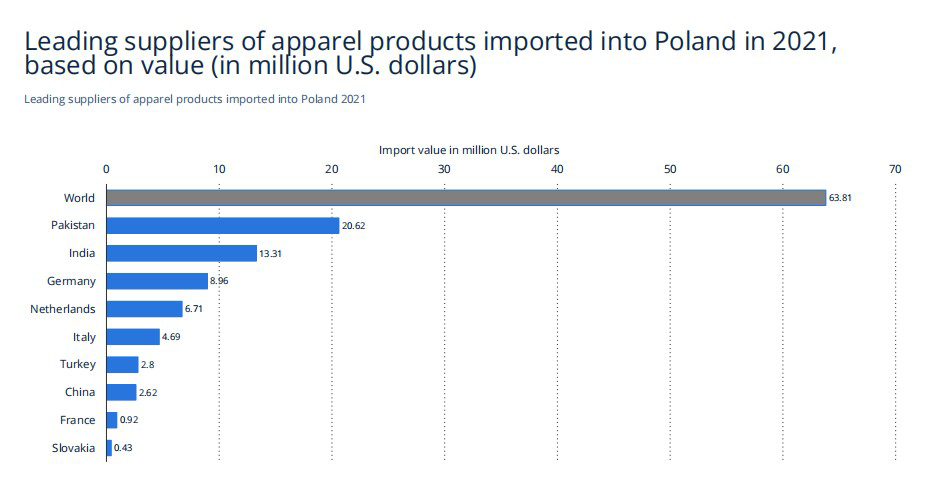 Descripción: En 2021, Pakistán fue el principal proveedor de prendas de vestir a Polonia, con importaciones valoradas en aproximadamente 20,6 millones de dólares estadounidenses. India ocupó el segundo lugar, con importaciones a Polonia por un valor aproximado de 13 millones de dólares estadounidenses.
Descripción: En 2021, Pakistán fue el principal proveedor de prendas de vestir a Polonia, con importaciones valoradas en aproximadamente 20,6 millones de dólares estadounidenses. India ocupó el segundo lugar, con importaciones a Polonia por un valor aproximado de 13 millones de dólares estadounidenses.
Principales destinos de las prendas de vestir exportadas desde Polonia en 2021, basado en el valor (en millones de dólares estadounidenses)
Principales destinos de las prendas de vestir exportadas desde Polonia en 2021
 Descripción: En 2021, Alemania fue el principal país exportador de prendas de vestir en Polonia, con exportaciones valoradas en aproximadamente 25 millones de dólares estadounidenses. España ocupó el segundo lugar, con exportaciones de Polonia por valor de unos tres millones de dólares estadounidenses.
Descripción: En 2021, Alemania fue el principal país exportador de prendas de vestir en Polonia, con exportaciones valoradas en aproximadamente 25 millones de dólares estadounidenses. España ocupó el segundo lugar, con exportaciones de Polonia por valor de unos tres millones de dólares estadounidenses.
Importaciones y exportaciones de calzado en Polonia de 2017 a 2021 (en millones euros)
Importaciones y exportaciones de calzado en Polonia 2017-2021
 Descripción: En 2021 aumentó el intercambio de mercancías en el mercado del calzado en Polonia. El valor de las importaciones aumentó más del 11 por ciento en comparación con el año anterior, mientras que el valor de las exportaciones aumentó más del 14 por ciento.
Descripción: En 2021 aumentó el intercambio de mercancías en el mercado del calzado en Polonia. El valor de las importaciones aumentó más del 11 por ciento en comparación con el año anterior, mientras que el valor de las exportaciones aumentó más del 14 por ciento.
Importaciones y exportaciones de calzado y sombrerería en Polonia en 2021, por principales países (en 1.000 euros)
Importaciones y exportaciones de calzado y sombrerería en Polonia en 2021, por principales países
 Descripción: En 2021, el mayor exportador de calzado, sombrerería, etc. a Polonia fue China. El valor de las importaciones procedentes de China ascendió a más de 1,33 mil millones de euros. Por otro lado, la exportación más importante de calzado y sombrerería de Polonia fue a Alemania.(mil millones de euros).
Descripción: En 2021, el mayor exportador de calzado, sombrerería, etc. a Polonia fue China. El valor de las importaciones procedentes de China ascendió a más de 1,33 mil millones de euros. Por otro lado, la exportación más importante de calzado y sombrerería de Polonia fue a Alemania.(mil millones de euros).
Importaciones y exportaciones de artículos de viaje, bolsos de mano y contenedores similares en Polonia de 2017 a 2021 (en millones de euros)
Importaciones y exportaciones de bolsos en Polonia 2017-2021
 Descripción: En 2021 aumentó el intercambio de mercancías en el mercado de bolsos en Polonia. El valor de las importaciones aumentó más del 17,3 por ciento en comparación con el año anterior, mientras que el valor de las exportaciones aumentó un 34,7 por ciento.
Descripción: En 2021 aumentó el intercambio de mercancías en el mercado de bolsos en Polonia. El valor de las importaciones aumentó más del 17,3 por ciento en comparación con el año anterior, mientras que el valor de las exportaciones aumentó un 34,7 por ciento.
Importaciones y exportaciones de cueros, manufacturas de cuero y prendas confeccionadas. Peletería en Polonia de 2017 a 2021 (en millones de euros)
Importaciones y exportaciones de artículos de cuero en Polonia 2017-2021
 Descripción: En 2021 aumentó el intercambio de bienes en el mercado del cuero en Polonia. El valor de las importaciones aumentó un 16 por ciento en comparación con el año anterior, mientras que el valor de las exportaciones también creció más del 11 por ciento.
Descripción: En 2021 aumentó el intercambio de bienes en el mercado del cuero en Polonia. El valor de las importaciones aumentó un 16 por ciento en comparación con el año anterior, mientras que el valor de las exportaciones también creció más del 11 por ciento.
03 Comercio minorista
En esta sección, exploramos el panorama minorista, incluidas las marcas populares de ropa y calzado, las preferencias de los consumidores y el cambio hacia las compras en línea. Investigamos las razones detrás de las decisiones de compra, las características de los productos más buscadas y el impacto de COVID-19 en las ventas minoristas.
Principales marcas de ropa y calzado en Polonia en 2022, por valor de marca (en millones de zlotys)
Ranking de marcas de ropa y calzado en Polonia 2022, por valor
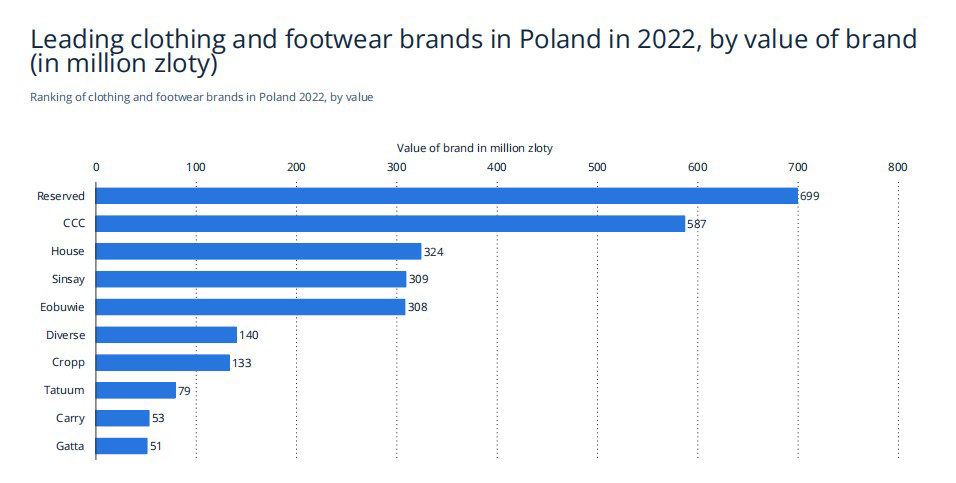 Descripción: The Polish clothing and apparel brand – Reserved opens the ranking of the most valuable clothing and footwear brands in Poland in 2022, followed by footwear chain CCC.
Descripción: The Polish clothing and apparel brand – Reserved opens the ranking of the most valuable clothing and footwear brands in Poland in 2022, followed by footwear chain CCC.
Número de tiendas minoristas de calzado y artículos de cuero en Polonia desde 2017 a 2021
Número de tiendas minoristas de calzado y artículos de cuero en Polonia 2017-2021
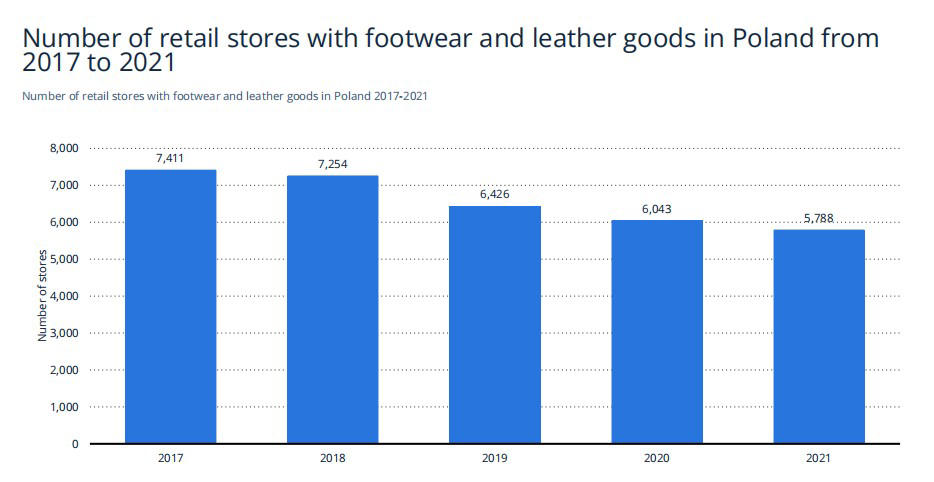 Descripción: En 2021, el número de tiendas minoristas de calzado y artículos de cuero en Polonia disminuyó un 4,2 por ciento en comparación con el año anterior.
Descripción: En 2021, el número de tiendas minoristas de calzado y artículos de cuero en Polonia disminuyó un 4,2 por ciento en comparación con el año anterior.
Tiendas más populares donde los consumidores compran ropa y zapatos en Polonia en 2022
Tiendas populares con ropa y calzado en Polonia 2022
 Descripción: En 2022, el 24 por ciento de los encuestados en Polonia compraron ropa o calzado de la marca Reserved. h&Le siguió la cadena M con un 23 por ciento.
Descripción: En 2022, el 24 por ciento de los encuestados en Polonia compraron ropa o calzado de la marca Reserved. h&Le siguió la cadena M con un 23 por ciento.
Tiendas más populares donde los consumidores compran ropa y zapatos en Polonia en 2022, por género
Tiendas populares con ropa y calzado en Polonia 2022, por género
 Descripción: En 2022, H.&M en Polonia fue visitado con más frecuencia por mujeres (27 por ciento) que por hombres (15 por ciento).
Descripción: En 2022, H.&M en Polonia fue visitado con más frecuencia por mujeres (27 por ciento) que por hombres (15 por ciento).
Tiendas de ropa y calzado más populares en Polonia en 2022, por canal de compra
Tiendas con tiendas de ropa y calzado más populares en Polonia 2022, por canal
 Descripción: The definite leader of traditional sales in Poland in 2022 was Reserved – as many as 54 percent of respondents were shopping there. In the online channel, this chain had a share of 27 percent. In the online channel the most popular was Zalando, with a
Descripción: The definite leader of traditional sales in Poland in 2022 was Reserved – as many as 54 percent of respondents were shopping there. In the online channel, this chain had a share of 27 percent. In the online channel the most popular was Zalando, with a
participación del 38 por ciento.
Ranking de las tiendas online mejor valoradas de ropa y calzado en Polonia en 2022
Las mejores tiendas online de ropa y calzado en Polonia en 2022, según la tasa más alta
 Descripción: En 2022, la tienda de calzado online eobuwie.pl encabezó el ranking de tiendas online de ropa y calzado en Polonia, alcanzando casi 56 puntos en esta categoría.
Descripción: En 2022, la tienda de calzado online eobuwie.pl encabezó el ranking de tiendas online de ropa y calzado en Polonia, alcanzando casi 56 puntos en esta categoría.
Gasto promedio mensual per cápita en ropa y calzado en Polonia de 2000 a 2021 (en zlotys)
Gasto mensual medio per cápita en ropa y calzado en Polonia 2000-2021
 Descripción: El gasto de los polacos en ropa y calzado aumentó durante el período observado. En 2021, los consumidores gastaron casi 58 zloty al mes en estos productos.
Descripción: El gasto de los polacos en ropa y calzado aumentó durante el período observado. En 2021, los consumidores gastaron casi 58 zloty al mes en estos productos.
Rentabilidad bruta y neta de las ventas en el sector de confección de prendas de vestir en Polonia de 2017 a 2022
Indicador de rentabilidad de la facturación bruta y neta en el mercado de la confección en Polonia 2017-2022
 Descripción: En 2018, el sector de fabricación de prendas de vestir registró el mayor retorno de las ventas bruto y neto, con una proporción del 9,1 y el 7,9 por ciento, respectivamente. En 2022, el indicador de rentabilidad neta del volumen de negocios disminuyó respecto al año anterior, alcanzando el siete por ciento.
Descripción: En 2018, el sector de fabricación de prendas de vestir registró el mayor retorno de las ventas bruto y neto, con una proporción del 9,1 y el 7,9 por ciento, respectivamente. En 2022, el indicador de rentabilidad neta del volumen de negocios disminuyó respecto al año anterior, alcanzando el siete por ciento.
Cambio en los precios de la ropa y el calzado en Polonia de 2015 a 2021
Precios de ropa y calzado en Polonia 2015-2021
 Descripción: En 2021, los precios de la ropa y el calzado en Polonia disminuyeron un 0,2 por ciento en comparación con el año anterior. Según la fuente, los precios de la ropa bajaron un 0,5 por ciento y los del calzado aumentaron un 0,8 por ciento.
Descripción: En 2021, los precios de la ropa y el calzado en Polonia disminuyeron un 0,2 por ciento en comparación con el año anterior. Según la fuente, los precios de la ropa bajaron un 0,5 por ciento y los del calzado aumentaron un 0,8 por ciento.
Índice interanual de ventas minoristas de prendas de vestir, textiles y calzado en Precios constantes en Polonia de 2019 a 2021.
Crecimiento de las ventas minoristas de prendas de vestir, textiles y calzado en Polonia 2019-2021
 Descripción: En 2021, el índice de ventas minoristas de prendas de vestir, textiles y calzado a precios constantes interanual aumentó un 32 por ciento en comparación con 2020 en Polonia.
Descripción: En 2021, el índice de ventas minoristas de prendas de vestir, textiles y calzado a precios constantes interanual aumentó un 32 por ciento en comparación con 2020 en Polonia.
04 empresas
La sección de empresas profundiza en el desempeño financiero de los actores clave en el mercado polaco de moda y accesorios. Destacamos las cifras de ingresos de marcas conocidas y analizamos sus trayectorias de crecimiento.
Número de empresas de fabricación de prendas de vestir en Polonia desde 2020 a 2021, por número de empleados*
Número de empresas de fabricación de prendas de vestir en Polonia 2020-2021, por número de empleados
 Descripción: De un total de 1481, en 2021 había 1276 fabricantes de prendas de vestir en Polonia, con 49 empleados o menos.
Descripción: De un total de 1481, en 2021 había 1276 fabricantes de prendas de vestir en Polonia, con 49 empleados o menos.
Número de empresas de fabricación de textiles en Polonia de 2020 a 2021, por número de empleados*
Número de empresas manufactureras textiles en Polonia 2020-2021, por número de empleados
 Descripción: De un total de 818, en 2021 había 635 fabricantes textiles en Polonia, con 49 empleados o menos.
Descripción: De un total de 818, en 2021 había 635 fabricantes textiles en Polonia, con 49 empleados o menos.
Número de empresas fabricantes de artículos de cuero en Polonia desde 2020 hasta 2021, por número de empleados*
Número de empresas fabricantes de artículos de cuero en Polonia 2020-2021, por número de empleados
 Descripción: De un total de 334, en 2021 había 284 fabricantes de artículos de cuero en Polonia, con 49 empleados o menos.
Descripción: De un total de 334, en 2021 había 284 fabricantes de artículos de cuero en Polonia, con 49 empleados o menos.
Ingresos de las empresas que fabrican prendas de vestir en Polonia desde 2015 hasta 2022 (en millones de zlotys)
Ingresos de las empresas productoras de prendas de vestir en Polonia 2015-2022
 Descripción: Durante el período analizado, los ingresos de las empresas productoras de prendas de vestir en Polonia fluctuaron. En 2022, estos ingresos ascendieron a aproximadamente 5,3 mil millones de PLN.
Descripción: Durante el período analizado, los ingresos de las empresas productoras de prendas de vestir en Polonia fluctuaron. En 2022, estos ingresos ascendieron a aproximadamente 5,3 mil millones de PLN.
Ingresos del grupo LPP S.A. a nivel mundial de 2006 a 2022* (en millones zlotys)
Ingresos del grupo LPP S.A. a nivel mundial 2006-2022
 Descripción: En 2022, los ingresos del grupo LPP S.A. alcanzaron más de 15,9 mil millones de zloty en todo el mundo.
Descripción: En 2022, los ingresos del grupo LPP S.A. alcanzaron más de 15,9 mil millones de zloty en todo el mundo.
Resultados financieros en el segmento de ropa y joyería de VRG Capital Group en Polonia en 2021 (en millones de zlotys)
Financial results of the apparel and jewelry – VRG Capital Group in Poland 2021
 Descripción: Los ingresos por ventas del segmento de ropa y joyería de VRG Capital Group en Polonia en 2021 ascendieron a casi 1,1 mil millones de zloty. El beneficio neto de la venta de prendas de vestir ascendió a 386 millones de eslotis.
Descripción: Los ingresos por ventas del segmento de ropa y joyería de VRG Capital Group en Polonia en 2021 ascendieron a casi 1,1 mil millones de zloty. El beneficio neto de la venta de prendas de vestir ascendió a 386 millones de eslotis.
Variación interanual de los ingresos por venta minorista de CCC S.A. Capital Calzado del grupo en Polonia en 2021, por marca (en millones de zlotys)
Ingresos por ventas minoristas de la empresa de calzado CCC S.A. en Polonia 2021, por marca

Descripción: En el cuarto trimestre de 2021, una de las mayores empresas minoristas de calzado de Polonia y Europa Central registró un aumento del 46 por ciento en sus ingresos en comparación con el mismo período del año pasado. El mayor crecimiento lo han realizado las tiendas CCC.
Revenue from the sale of Wojas’ footwear in Poland from 2019 to 2022, by tipo de canal (en millones de zlotys)
Ingresos por ventas de la empresa de calzado Wojas en Polonia 2019-2022, por canal
 Descripción: En 2022, la empresa de calzado Wojas en Polonia logró unos ingresos netos consolidados de 331,5 millones de zloty, un aumento del 13,4 por ciento en comparación con el mismo período del año pasado. El crecimiento de ventas más significativo se registró en las ventas minoristas fuera de línea (+33,9 porcentaje interanual).
Descripción: En 2022, la empresa de calzado Wojas en Polonia logró unos ingresos netos consolidados de 331,5 millones de zloty, un aumento del 13,4 por ciento en comparación con el mismo período del año pasado. El crecimiento de ventas más significativo se registró en las ventas minoristas fuera de línea (+33,9 porcentaje interanual).
Ingresos por la venta realizada por Wittchen en Polonia de 2018 a 2022 (en millones de eslotis)
Ingresos por ventas de Wittchen en Polonia 2018-2022

Descripción: En 2022, Wittchen, productor de productos de cuero exclusivos en Polonia, obtuvo unos ingresos por ventas de aproximadamente 406 millones de zloty. Se trata de un aumento del 46,2 por ciento en comparación con el año anterior. Las mayores ventas provinieron del segmento minorista, alcanzando
más de 345 millones de zlotys.
Resultados financieros de Answear.com* en Polonia de 2020 a 2022 (en miles zlotys)
Resultados financieros de Answear.com en Polonia 2020-2022

Descripción: Año tras año, los ingresos por ventas obtenidos por la tienda online polaca Answear.com aumentaron. En 2022, la empresa también registró un beneficio neto de más de 25,8 millones de PLN.
05 Consumo
El comportamiento del consumidor juega un papel fundamental en la configuración del mercado de la moda. En esta sección, examinamos el gasto de consumo de los hogares en ropa y calzado, arrojando luz sobre los factores que impulsan las decisiones de gasto de los consumidores.
Gasto de consumo de los hogares en ropa en Polonia desde 2009 hasta 2021 (en millones de zlotys)
Gasto del consumidor en ropa en Polonia 2009-2021

Descripción: El gasto de consumo anual de los hogares en ropa en Polonia aumentó en 8,2 mil millones de zloty (+16,68 por ciento) en 2021. Con 57,2 mil millones de zloty, el gasto de consumo anual de los hogares alcanzó su valor más alto en el período observado.
período. En particular, el gasto de consumo anual de los hogares en esta industria ha aumentado continuamente durante los últimos años, a excepción de 2020.
Gasto de consumo de los hogares en calzado en Polonia desde 2009 hasta 2021 (en millones de zlotys)
Gasto del consumidor en calzado en Polonia 2009-2021
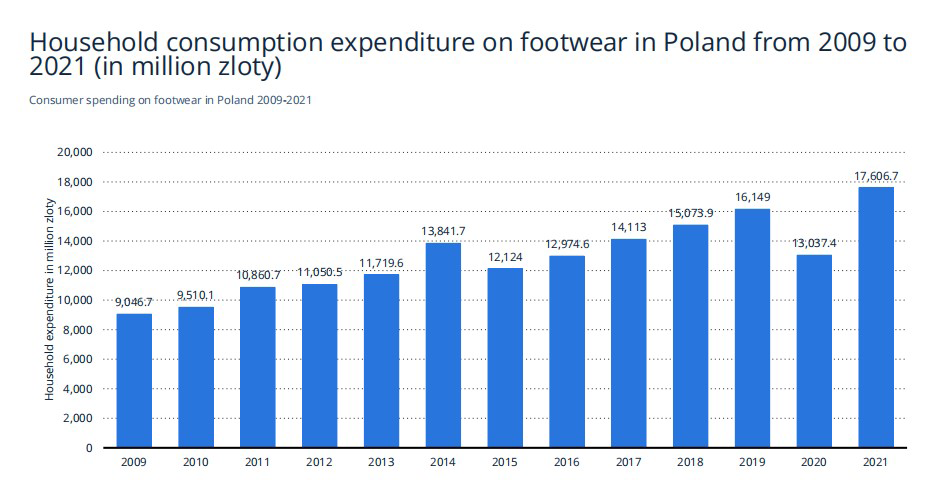 Descripción: El gasto de consumo anual de los hogares en calzado en Polonia aumentó significativamente en 2021 en 4,6 mil millones de zloty (+35,05 por ciento). Con 17,6 mil millones de zloty, el gasto de consumo anual de los hogares alcanzó su valor más alto en el periodo observado.
Descripción: El gasto de consumo anual de los hogares en calzado en Polonia aumentó significativamente en 2021 en 4,6 mil millones de zloty (+35,05 por ciento). Con 17,6 mil millones de zloty, el gasto de consumo anual de los hogares alcanzó su valor más alto en el periodo observado.
¿Por qué prefieres comprar ropa en tiendas físicas?
Razones para comprar ropa en tienda en Polonia 2022
Proporción de personas que compran ropa y calzado online en Polonia 2020-2022

Descripción: En 2022, las principales razones por las que los consumidores compraron ropa en las tiendas tradicionales de Polonia fueron la posibilidad de ver y tocar el producto y comprarlo directamente.
Proporción de personas que compran ropa, calzado y accesorios en línea en Polonia de 2020 a 2022
Proporción de personas que compran ropa y calzado online en Polonia 2020-2022
 Descripción: En 2022, casi el 73 por ciento de los polacos que compran ropa, zapatos y accesorios utilizaron regularmente el canal online para este fin.
Descripción: En 2022, casi el 73 por ciento de los polacos que compran ropa, zapatos y accesorios utilizaron regularmente el canal online para este fin.
Características del producto más importantes a la hora de realizar una compra de ropa en Polonia en 2022
Características del producto más importantes al comprar ropa en Polonia 2022
 Descripción: En 2022, la característica más importante del producto a la hora de comprar ropa en Polonia fue el precio adecuado. A continuación le siguió el material de alta calidad, duradero y reparable, con el 60 por ciento de los votos de los encuestados.
Descripción: En 2022, la característica más importante del producto a la hora de comprar ropa en Polonia fue el precio adecuado. A continuación le siguió el material de alta calidad, duradero y reparable, con el 60 por ciento de los votos de los encuestados.
Canales donde los consumidores buscarán productos de moda en Polonia en 2022
Canales donde los consumidores buscan productos de moda en Polonia 2022

Descripción: En 2022, el 42 por ciento de los encuestados polacos buscaba productos de moda en portales como Allegro, Amazon, Facebook y Aliexpress. Por otro lado, alrededor del 10 por ciento buscaba comprar productos de moda a través de las redes sociales.
Razones por las que la gente comprará ropa u otros productos de moda en Polonia en 2022
Razones por las que la gente compra ropa u otros productos de moda en Polonia 2022
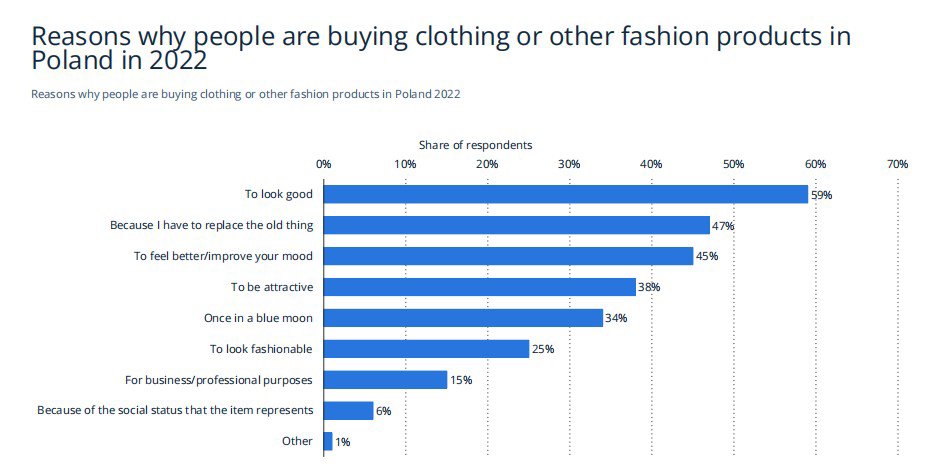 Descripción: En 2022, más de la mitad de los encuestados en Polonia compraban ropa u otros productos de moda para lucir bien, y casi la mitad de los polacos tuvieron que reemplazar el producto antiguo por uno nuevo.
Descripción: En 2022, más de la mitad de los encuestados en Polonia compraban ropa u otros productos de moda para lucir bien, y casi la mitad de los polacos tuvieron que reemplazar el producto antiguo por uno nuevo.
Razones para llevar ropa de marcas de moda polacas en Polonia en 2022
Razones para usar ropa de marcas de moda polacas en 2022
 Descripción: En 2022, más de la mitad de los encuestados polacos vestían ropa de marcas de moda polacas porque eran cómodas y de buena calidad. Por otro lado, el 44 por ciento los eligió por su precio favorable.
Descripción: En 2022, más de la mitad de los encuestados polacos vestían ropa de marcas de moda polacas porque eran cómodas y de buena calidad. Por otro lado, el 44 por ciento los eligió por su precio favorable.
Lo que te convencerá de determinadas marcas de moda en Polonia en 2022
Razones para elegir una marca de moda en Polonia 2022
 Descripción: En 2022, el estilo de la marca de moda convenció a casi la mitad de los encuestados polacos. Además, el diseño influyó en el 36 por ciento de las personas.
Descripción: En 2022, el estilo de la marca de moda convenció a casi la mitad de los encuestados polacos. Además, el diseño influyó en el 36 por ciento de las personas.
Razones para usar ropa usada en lugar de nueva en Polonia en 2022
Razones para usar ropa usada en lugar de nueva en Polonia 2022
 Descripción: En 2022, la mitad de los encuestados en Polonia afirmaron que la razón principal por la que utilizaban ropa usada en lugar de nueva era su compra barata.
Descripción: En 2022, la mitad de los encuestados en Polonia afirmaron que la razón principal por la que utilizaban ropa usada en lugar de nueva era su compra barata.
06 Impacto de la COVID-19
La pandemia de COVID-19 tuvo un profundo impacto en diversas industrias, incluida la moda. En esta sección profundizamos en cómo la pandemia afectó el comportamiento del consumidor, la producción, las ventas y el surgimiento del comercio electrónico como canal dominante para las compras de moda.
Cambio en las ventas de productos FMCG debido al coronavirus (COVID-19) Brote en Polonia entre febrero y mayo de 2020, por categoría de producto
Aumento de las ventas de productos FMCG debido a COVID-19 Polonia 2020, por categoría de producto
 Descripción: La aparición de la epidemia de coronavirus en Polonia en marzo de 2020 tuvo un impacto significativo en los cambios de compras de los polacos, lo que se tradujo en el volumen de ventas de productos. En el período de febrero a marzo, el mayor aumento de ventas se registró en productos de la categoría de salud, como suplementos dietéticos o medicamentos de venta libre. La caída más significativa se observó en la venta de cosméticos y perfumes, hasta un 41 por ciento.
Descripción: La aparición de la epidemia de coronavirus en Polonia en marzo de 2020 tuvo un impacto significativo en los cambios de compras de los polacos, lo que se tradujo en el volumen de ventas de productos. En el período de febrero a marzo, el mayor aumento de ventas se registró en productos de la categoría de salud, como suplementos dietéticos o medicamentos de venta libre. La caída más significativa se observó en la venta de cosméticos y perfumes, hasta un 41 por ciento.
Cambio en la producción vendida de la industria en Polonia entre 2020 y 2022, por sector
Producción vendida de la industria en Polonia 2022, por sector
 Descripción: En marzo de 2020, la producción vendida de la industria fue un 2,3 por ciento menor que en marzo de 2019. Después de eliminar el impacto de los factores estacionales en Polonia, la caída de la producción en marzo fue aún mayor y ascendió al 4,8 por ciento interanual. En la mayoría de los principales grupos industriales se registró en marzo una disminución anual de la producción. La producción de automóviles cayó un 29 por ciento y la de productos farmacéuticos aumentó un 40 por ciento. En abril, la producción vendida de la industria fue un 24,6 por ciento menor.
Descripción: En marzo de 2020, la producción vendida de la industria fue un 2,3 por ciento menor que en marzo de 2019. Después de eliminar el impacto de los factores estacionales en Polonia, la caída de la producción en marzo fue aún mayor y ascendió al 4,8 por ciento interanual. En la mayoría de los principales grupos industriales se registró en marzo una disminución anual de la producción. La producción de automóviles cayó un 29 por ciento y la de productos farmacéuticos aumentó un 40 por ciento. En abril, la producción vendida de la industria fue un 24,6 por ciento menor.
Cambio en la facturación de las tiendas que operan en centros comerciales debido a laBrote de coronavirus (COVID-19) en Polonia en marzo de 2020, por categoría de producto
Cambio de facturación de tiendas que operan en centros comerciales debido a COVID-19 Polonia 2020
 Descripción: En marzo de 2020, el volumen de negocios de los inquilinos que operan en centros comerciales vigilados en Polonia disminuyó un 62 por ciento en comparación con el año anterior. Las caídas más significativas las registró la industria de la moda (73 por ciento interanual).
Descripción: En marzo de 2020, el volumen de negocios de los inquilinos que operan en centros comerciales vigilados en Polonia disminuyó un 62 por ciento en comparación con el año anterior. Las caídas más significativas las registró la industria de la moda (73 por ciento interanual).
¿Qué tiendas visitarás en primer lugar cuando vuelvan a abrir después del ¿Bloqueo por el coronavirus (COVID-19)?
Tipo de tiendas que visitará después de reabrir debido al cierre de COVID-19 en Polonia 2020
 Descripción: El Primer Ministro polaco anunció que a partir del 4 de mayo de 2020 se reabrirían los centros comerciales en Polonia después del cierre del coronavirus (COVID-19). Su disponibilidad se irá restableciendo paulatinamente debido a las restricciones introducidas (límite de personas, cierre de restaurantes en los centros comerciales). Tras la reapertura de los centros comerciales, más del 38 por ciento de los polacos visitarán las tiendas de ropa. El segundo tipo de comercio que los encuestados tienen previsto visitar en primer lugar será el de equipamiento de interior y jardinería.
Descripción: El Primer Ministro polaco anunció que a partir del 4 de mayo de 2020 se reabrirían los centros comerciales en Polonia después del cierre del coronavirus (COVID-19). Su disponibilidad se irá restableciendo paulatinamente debido a las restricciones introducidas (límite de personas, cierre de restaurantes en los centros comerciales). Tras la reapertura de los centros comerciales, más del 38 por ciento de los polacos visitarán las tiendas de ropa. El segundo tipo de comercio que los encuestados tienen previsto visitar en primer lugar será el de equipamiento de interior y jardinería.
Pedidos cancelados de fabricantes de ropa por el coronavirus (COVID-19) en Polonia en 2020
Pedidos cancelados de fabricantes de ropa debido al COVID-19 en Polonia 2020
 Descripción: Debido a la crisis provocada por la epidemia de coronavirus en 2020, uno de cada dos fabricantes de ropa en Polonia experimentó cancelaciones de pedidos del 50 al 99 por ciento.
Descripción: Debido a la crisis provocada por la epidemia de coronavirus en 2020, uno de cada dos fabricantes de ropa en Polonia experimentó cancelaciones de pedidos del 50 al 99 por ciento.
Lugares donde la gente compró ropa online durante el coronavirus (COVID-19) pandemia en Polonia en 2021
Lugares donde la gente compró ropa online durante la pandemia de COVID-19 en Polonia 2021
 Descripción: In 2021, during the coronavirus (COVID-19) pandemic, Poles were most likely to buy clothes online through shopping platforms with a variety of products – 59 percent, chain stores – 44 percent, and shopping platforms dedicated to clothes – 30 percent.
Descripción: In 2021, during the coronavirus (COVID-19) pandemic, Poles were most likely to buy clothes online through shopping platforms with a variety of products – 59 percent, chain stores – 44 percent, and shopping platforms dedicated to clothes – 30 percent.
Compra de ropa online durante la pandemia de coronavirus (COVID-19), por edad en Polonia en 2021
Compra de ropa online durante la pandemia de COVID-19, por edad en Polonia 2021
 Descripción: In 2021, during the coronavirus (COVID-19) pandemic, the highest percentage of respondents aged 18-24 bought clothes online – 82 percent.
Descripción: In 2021, during the coronavirus (COVID-19) pandemic, the highest percentage of respondents aged 18-24 bought clothes online – 82 percent.
07 perspectiva
Por último, ofrecemos información sobre las perspectivas futuras del mercado de la moda y los accesorios en Polonia. Proporcionamos pronósticos de ingresos, predecimos tendencias en el comercio electrónico y analizamos los patrones de gasto de los consumidores proyectados. Al observar las áreas de crecimiento potencial, nuestro objetivo es dotar a las partes interesadas de información valiosa para la toma de decisiones estratégicas.
Previsión de ingresos del comercio electrónico de moda en Polonia de 2017 a 2027 (en mil millones de dólares estadounidenses)
Previsión de ingresos del comercio electrónico de moda en Polonia 2017-2027
 Descripción: Se espera que los ingresos del comercio electrónico de la moda en Polonia crezcan hasta los 7.600 millones de dólares estadounidenses en 2027.
Descripción: Se espera que los ingresos del comercio electrónico de la moda en Polonia crezcan hasta los 7.600 millones de dólares estadounidenses en 2027.
Ingresos del mercado de la confección en Polonia de 2014 a 2027 (en millones Dólares estadounidenses)
Ingresos de la industria de la confección en Polonia 2014-2027
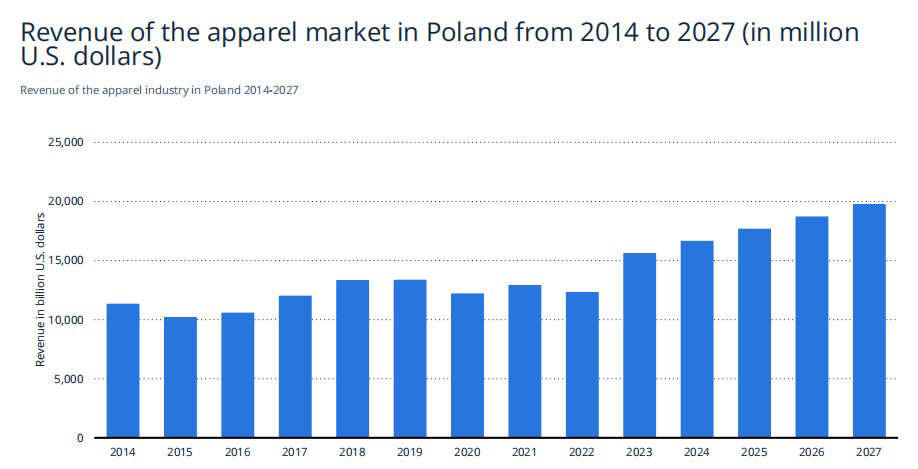 Descripción: Se pronosticó que los ingresos en el mercado de la confección en Polonia aumentarán continuamente entre 2023 y 2027 en un total de 4.132 millones de dólares (+26,5 por ciento). Se estima que los ingresos ascenderán a 19,7 mil millones de dólares estadounidenses en 2027.Encontrar más
Descripción: Se pronosticó que los ingresos en el mercado de la confección en Polonia aumentarán continuamente entre 2023 y 2027 en un total de 4.132 millones de dólares (+26,5 por ciento). Se estima que los ingresos ascenderán a 19,7 mil millones de dólares estadounidenses en 2027.Encontrar más
información sobre los ingresos en el mercado de la confección analizando países similares a Polonia, como Chequia y Hungría.
Ingresos del mercado del calzado en Polonia de 2018 a 2028 (en millones Dólares estadounidenses)
Ingresos de la industria del calzado en Polonia 2018-2028
 Descripción: Se pronostica que los ingresos en el mercado del calzado en Polonia aumentarán continuamente entre 2023 y 2028 en un total de 417,9 millones de dólares estadounidenses (+14,47 por ciento). Se estima que los ingresos ascenderán a 3.300 millones de dólares estadounidenses en 2028.Encontrar más
Descripción: Se pronostica que los ingresos en el mercado del calzado en Polonia aumentarán continuamente entre 2023 y 2028 en un total de 417,9 millones de dólares estadounidenses (+14,47 por ciento). Se estima que los ingresos ascenderán a 3.300 millones de dólares estadounidenses en 2028.Encontrar más
información sobre los ingresos en el mercado del calzado observando otros países, como Tailandia e Indonesia.
Ingresos de los relojes & mercado de la joyería en Polonia de 2013 a 2026 (en millones de dólares estadounidenses)
Ingresos de los relojes & industria de la joyería en Polonia 2013-2026
 Descripción: Los ingresos en los relojes. & Se pronostica que el segmento de joyería del mercado de accesorios en Polonia aumentará continuamente entre 2023 y 2026 en un total de 82,8 millones de dólares estadounidenses (+10,15 por ciento). Se estima que los ingresos ascenderán a 898,88 millones.
Descripción: Los ingresos en los relojes. & Se pronostica que el segmento de joyería del mercado de accesorios en Polonia aumentará continuamente entre 2023 y 2026 en un total de 82,8 millones de dólares estadounidenses (+10,15 por ciento). Se estima que los ingresos ascenderán a 898,88 millones.
Dólares estadounidenses en 2026. Encuentre más información sobre el mercado de Accesorios y sus segmentos. Aquí puede encontrar los ingresos del mercado de accesorios en Tailandia y los ingresos del mercado de accesorios en Indonesia.
Gasto total de los consumidores en ropa y calzado en Polonia desde 2013 hasta 2028 (en millones de dólares estadounidenses)
Gasto total de los consumidores en ropa y calzado en Polonia 2013-2028
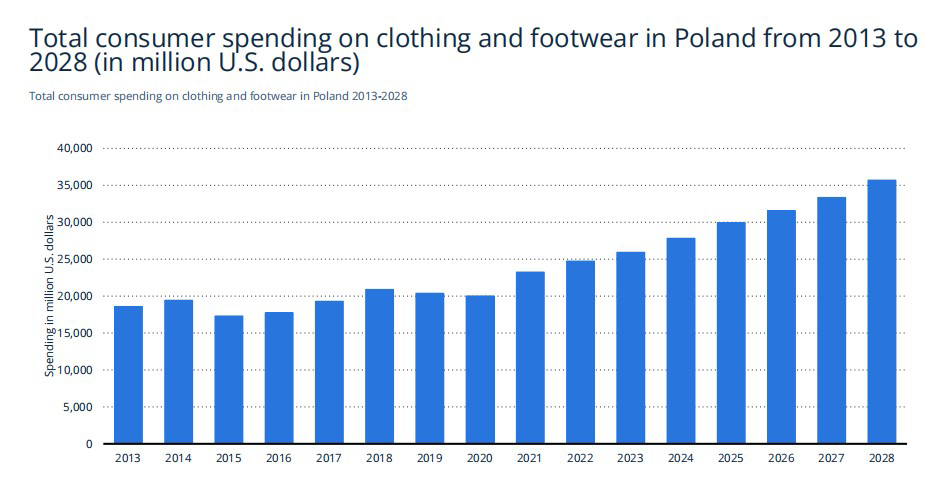 Descripción: Se pronostica que el gasto total de los consumidores en ropa y calzado en Polonia aumentará continuamente entre 2023 y 2028 en un total de 9,77 mil millones de dólares estadounidenses (+37,67 por ciento). Se estima que el gasto relacionado con la moda asciende a 35,7 mil millones de dólares.
Descripción: Se pronostica que el gasto total de los consumidores en ropa y calzado en Polonia aumentará continuamente entre 2023 y 2028 en un total de 9,77 mil millones de dólares estadounidenses (+37,67 por ciento). Se estima que el gasto relacionado con la moda asciende a 35,7 mil millones de dólares.
dólares en 2028.
Gasto real per cápita del consumidor en ropa y calzado en Polonia de 2013 a 2028 (en dólares estadounidenses)
Gasto real del consumidor per cápita en ropa y calzado en Polonia 2013-2028
 Descripción: Se pronosticó que el gasto real del consumidor per cápita en ropa y calzado en Polonia aumentará continuamente entre 2023 y 2028 en un total de 639,3 dólares estadounidenses (+62,34 por ciento). Después del quinto año consecutivo de aumento, se estima que el gasto real per cápita relacionado con la moda alcanzará los 1,66 mil dólares estadounidenses y, por lo tanto, un nuevo pico en 2028. En particular, el gasto real per cápita del consumidor en ropa y calzado aumentó continuamente durante los últimos años. .
Descripción: Se pronosticó que el gasto real del consumidor per cápita en ropa y calzado en Polonia aumentará continuamente entre 2023 y 2028 en un total de 639,3 dólares estadounidenses (+62,34 por ciento). Después del quinto año consecutivo de aumento, se estima que el gasto real per cápita relacionado con la moda alcanzará los 1,66 mil dólares estadounidenses y, por lo tanto, un nuevo pico en 2028. En particular, el gasto real per cápita del consumidor en ropa y calzado aumentó continuamente durante los últimos años. .
Valor del mercado de ropa, calzado y complementos de lujo en Polonia de 2014 a 2026 (en millones de zlotys)
Valor del mercado de ropa, calzado y accesorios de lujo en Polonia 2014-2026
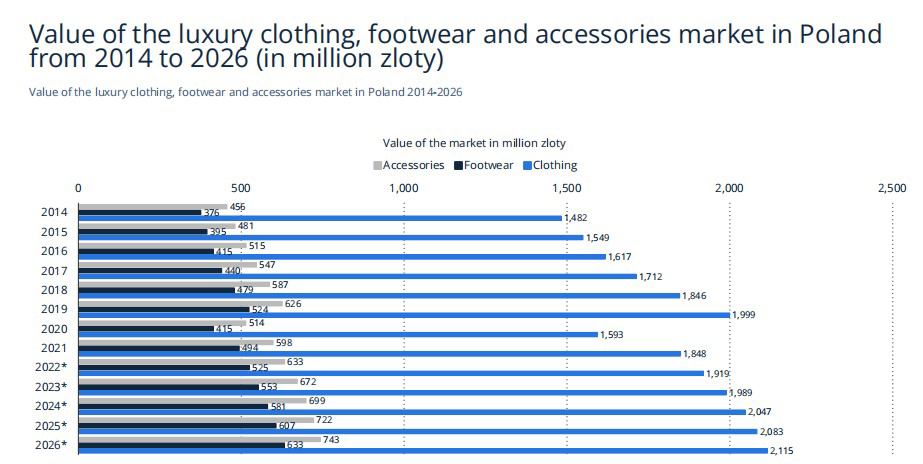 Descripción: En 2021, el valor del mercado de ropa, calzado y accesorios de lujo superó los 2.900 millones de zlotys en Polonia. Según el crecimiento anual medio previsto del 3,5 por ciento, el valor del segmento superará los 3.500 millones de złoty en 2026.
Descripción: En 2021, el valor del mercado de ropa, calzado y accesorios de lujo superó los 2.900 millones de zlotys en Polonia. Según el crecimiento anual medio previsto del 3,5 por ciento, el valor del segmento superará los 3.500 millones de złoty en 2026.
Pensamiento final
El mercado de la moda y los accesorios en Polonia es una industria vibrante y dinámica que continúa evolucionando con las cambiantes preferencias de los consumidores y los avances tecnológicos. A medida que Polonia emerge como un actor destacado en el ámbito mundial de la moda, presenta interesantes oportunidades para empresas e inversores. Al comprender las tendencias actuales y las perspectivas futuras, las partes interesadas pueden tomar decisiones informadas para prosperar en este mercado competitivo.
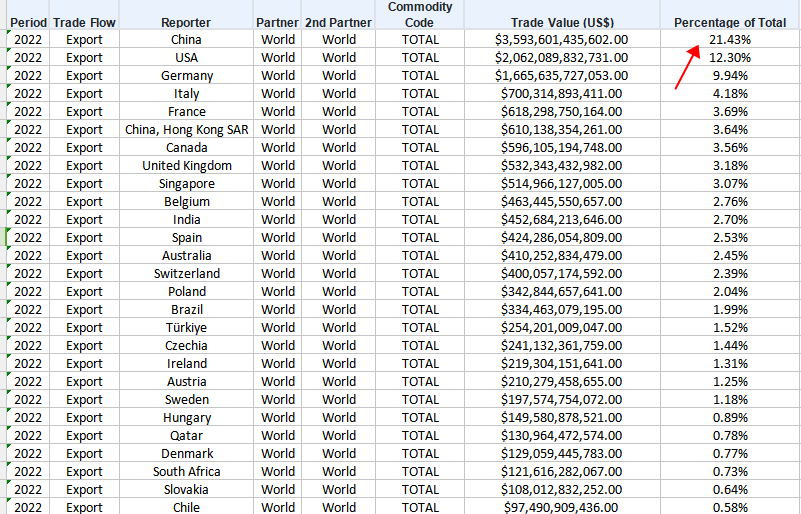

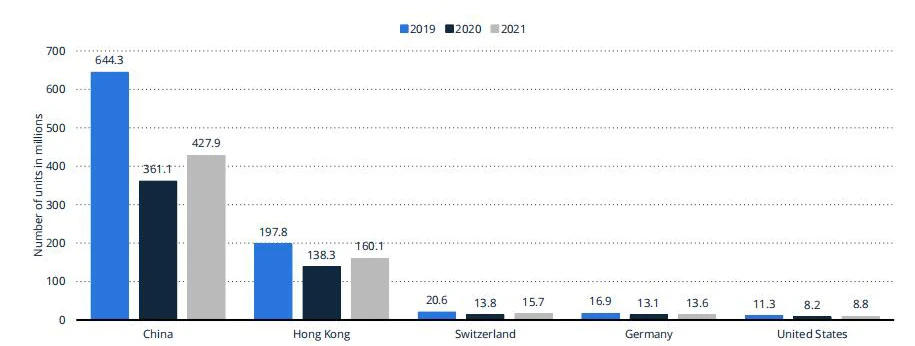
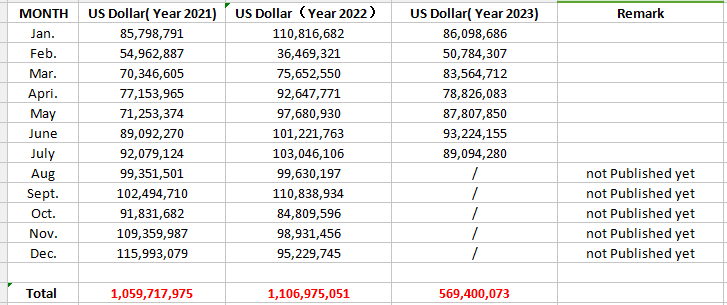
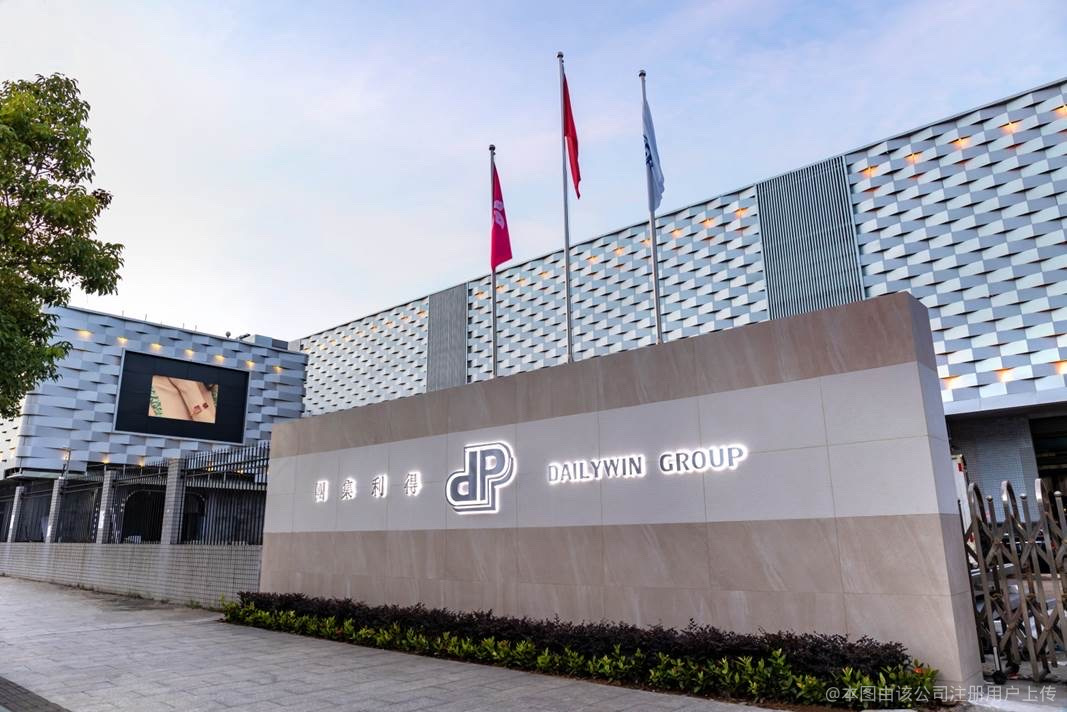
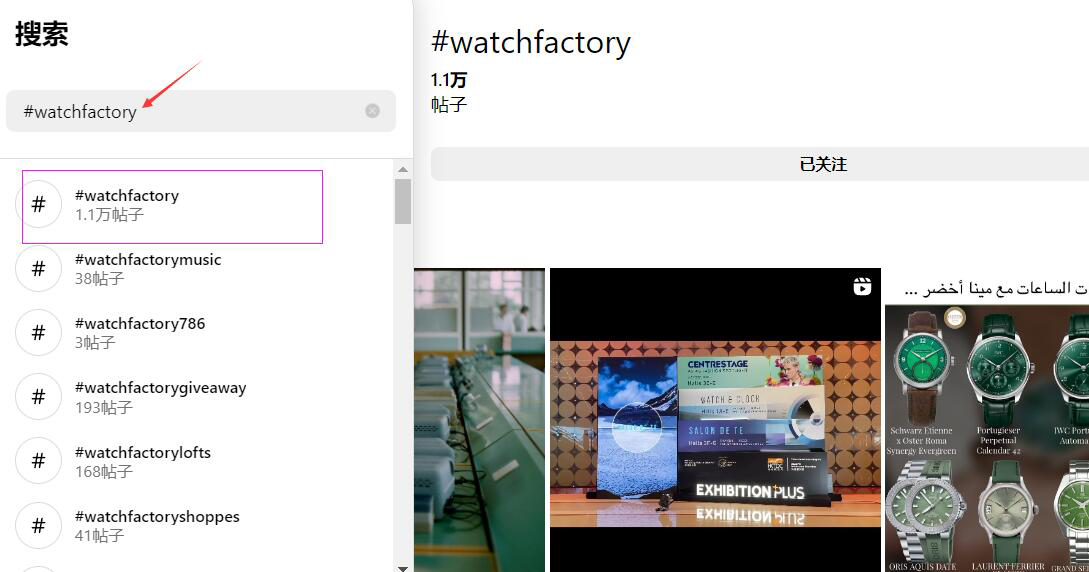
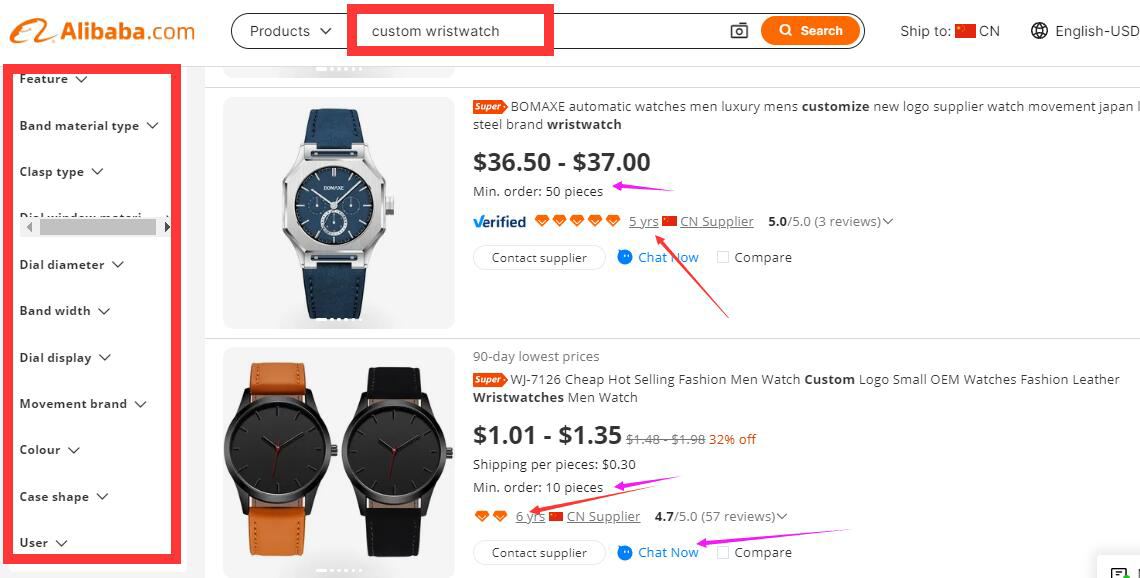




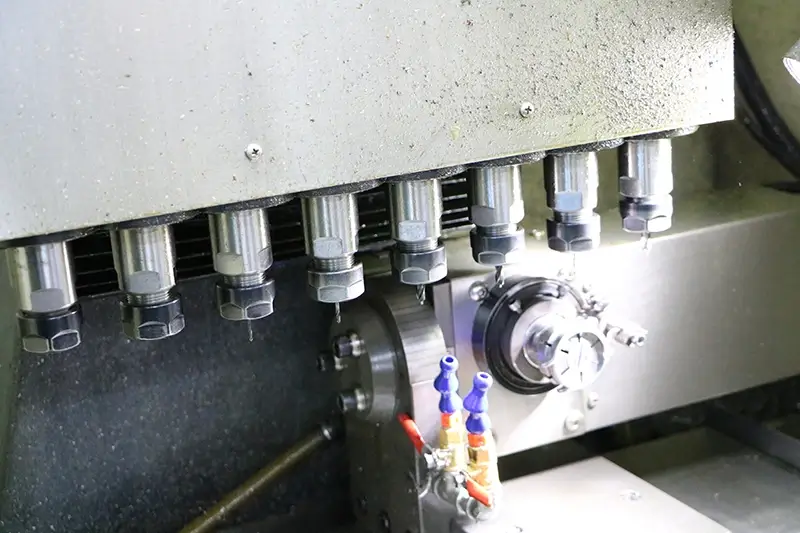
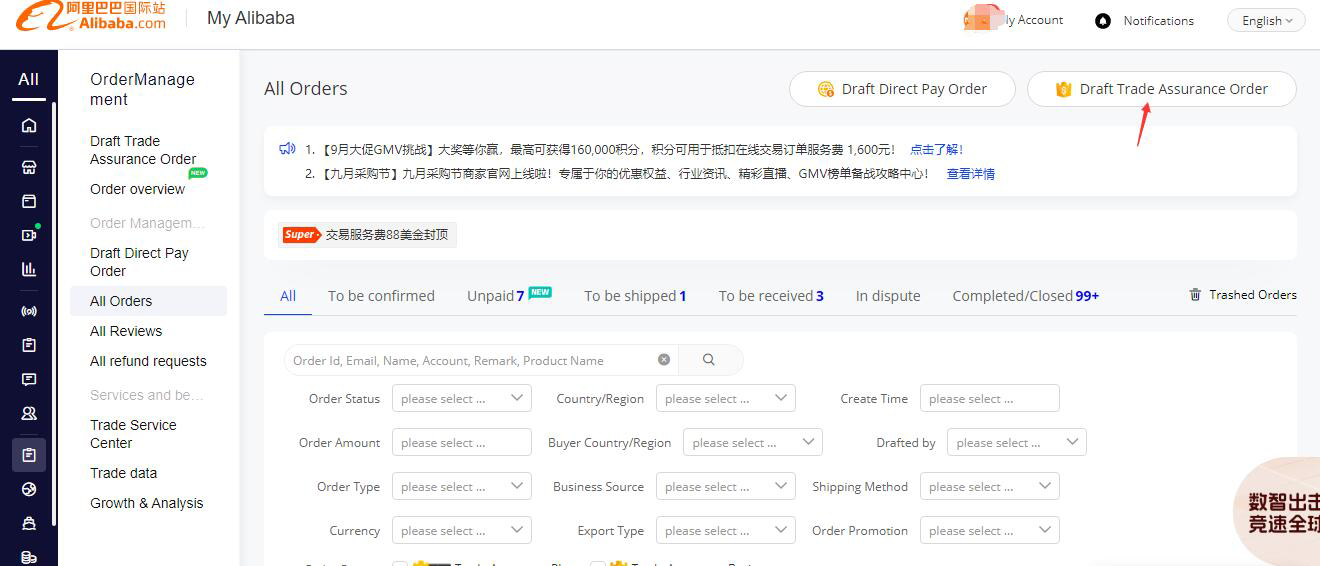
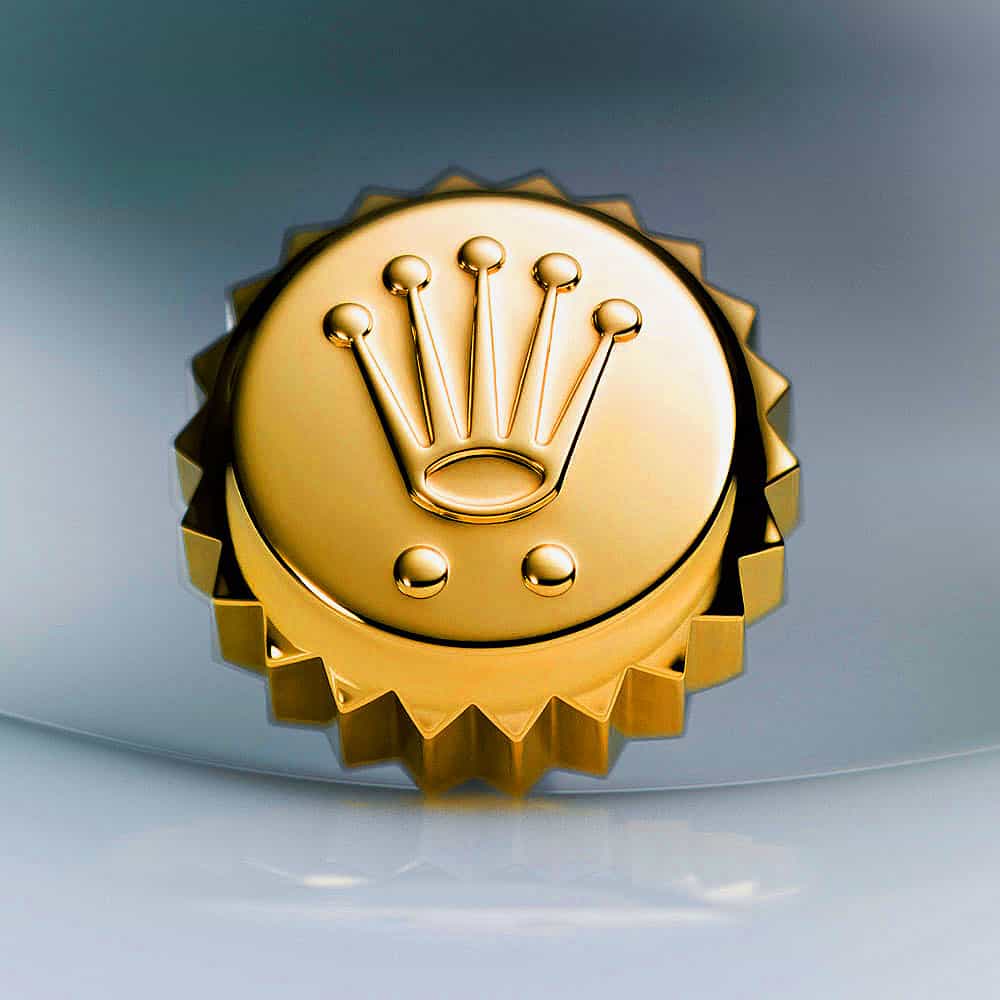
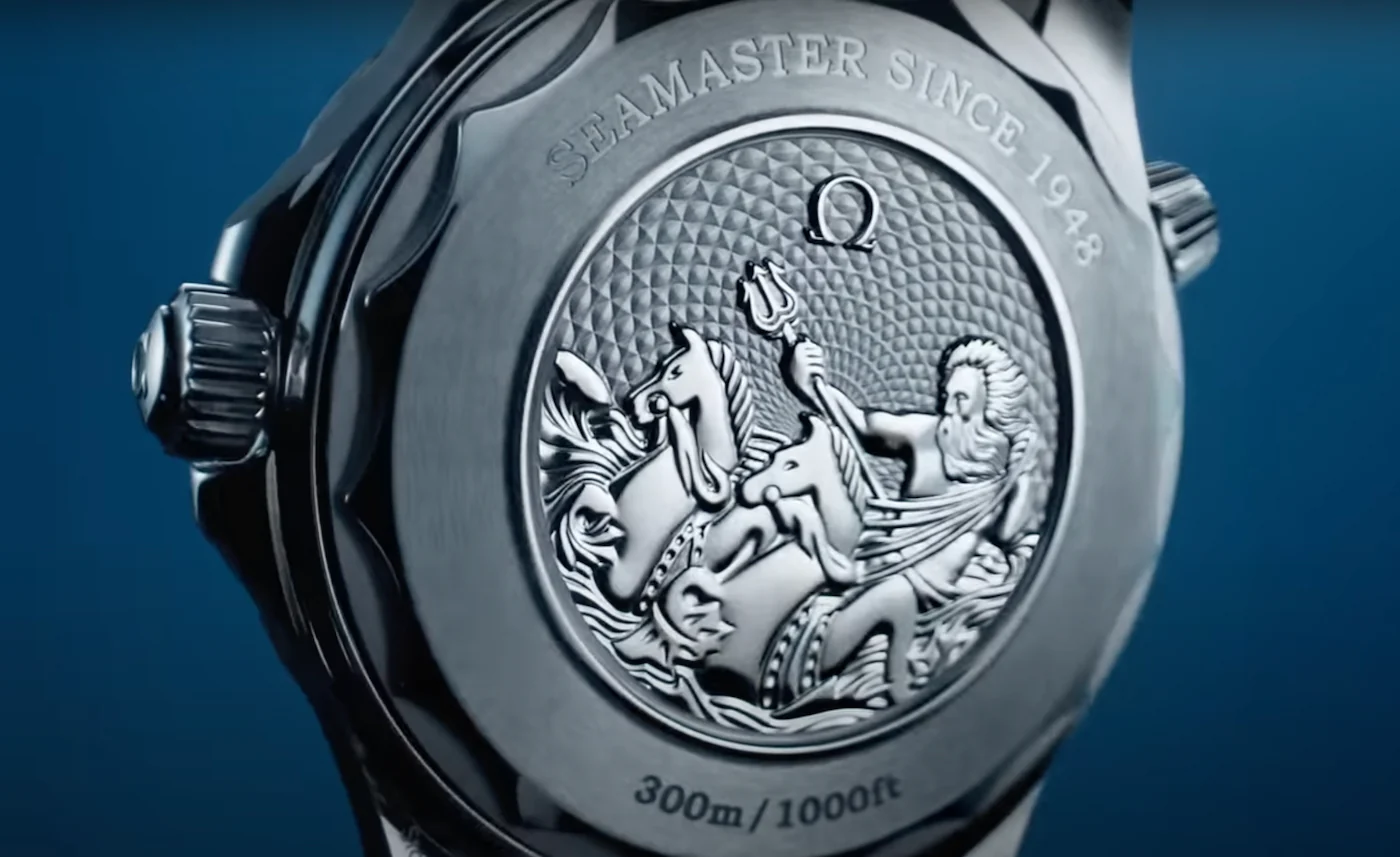
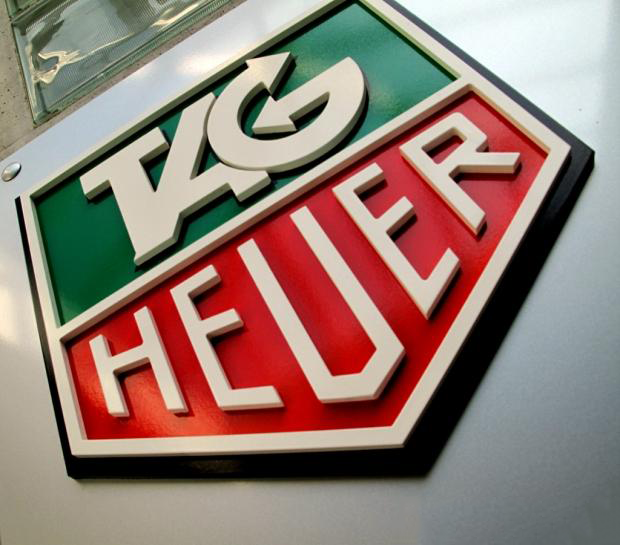


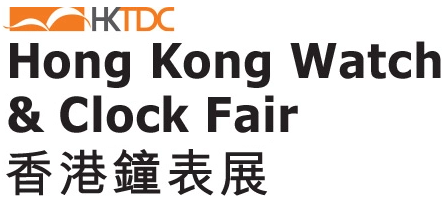
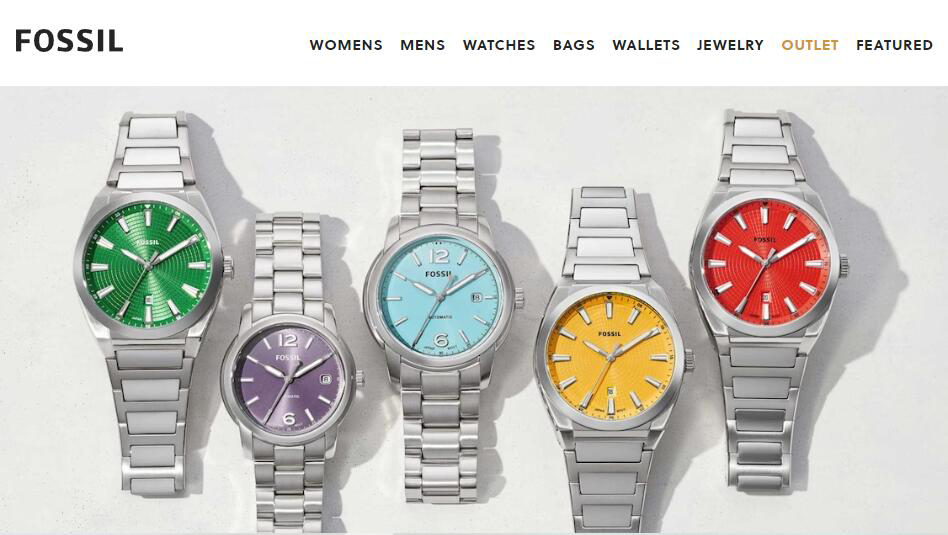
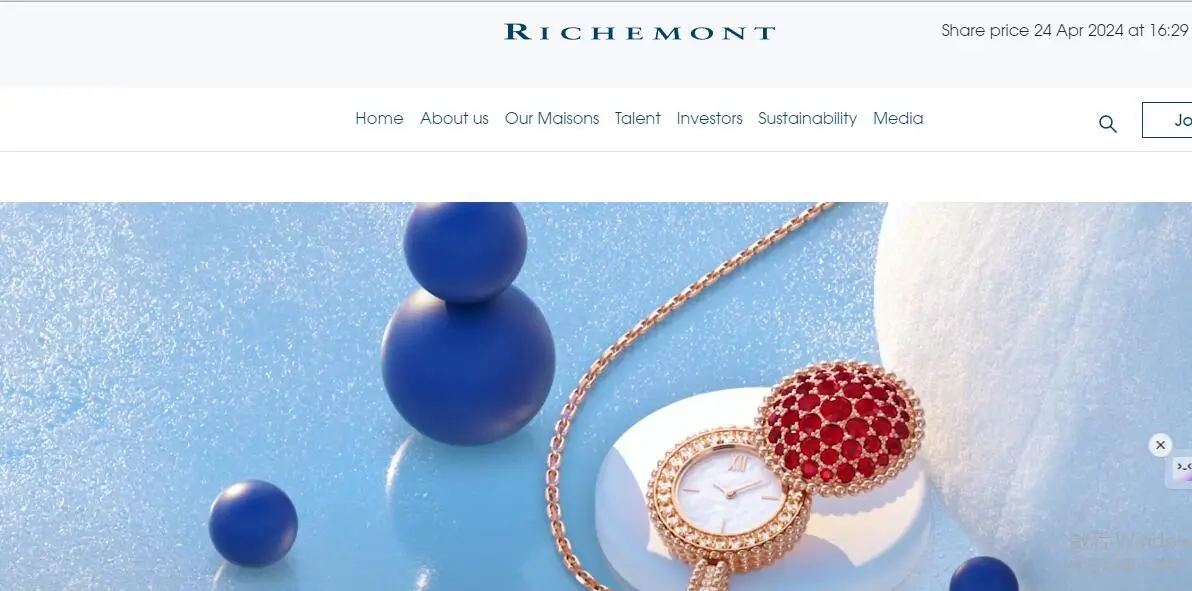

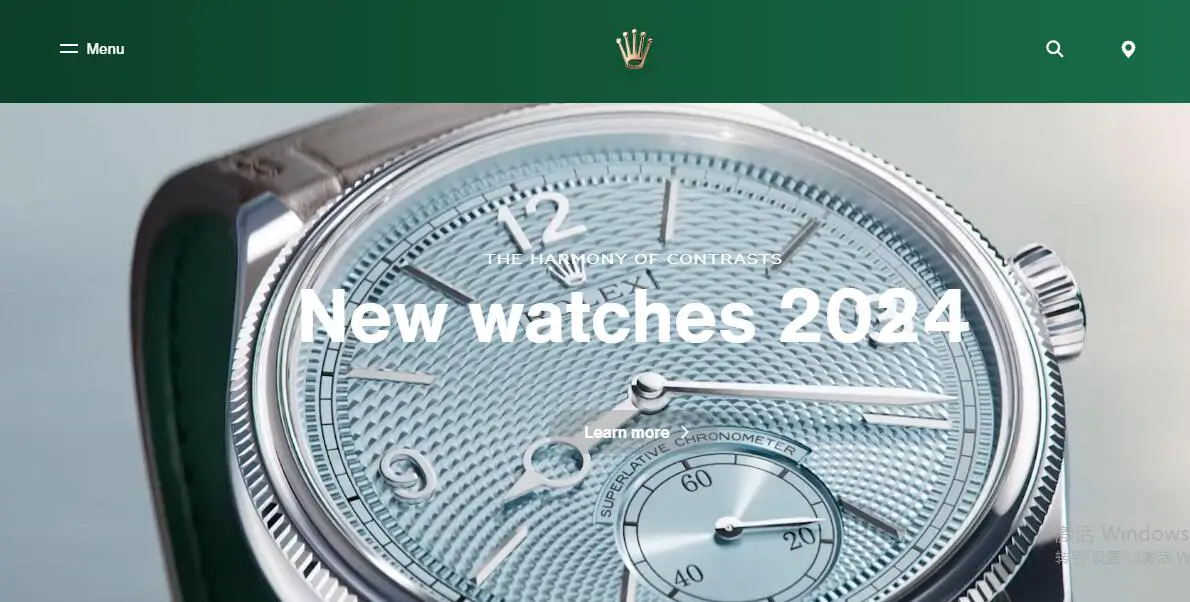
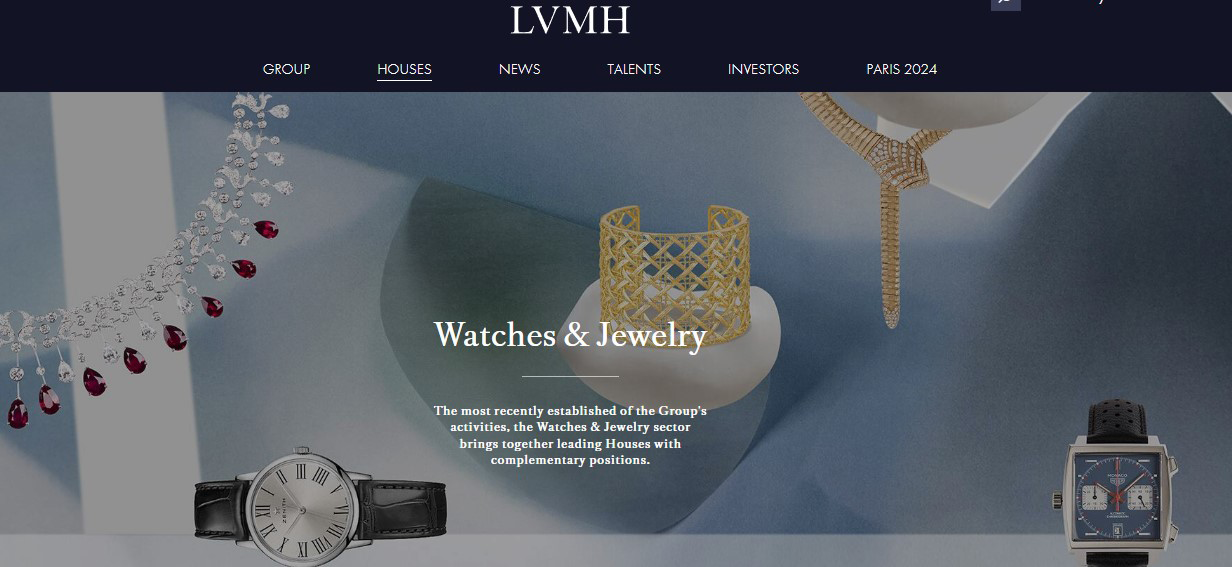
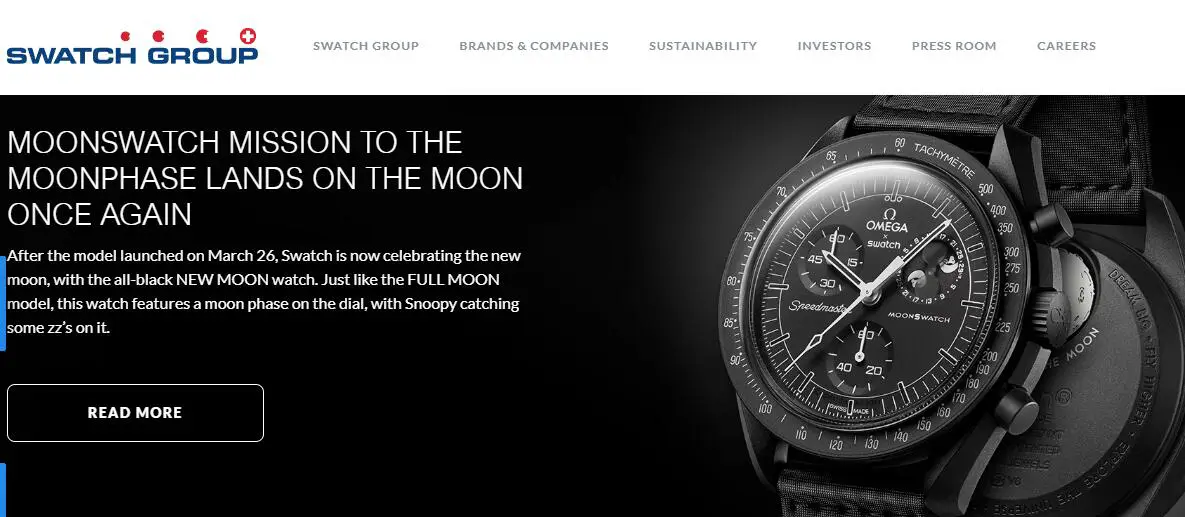
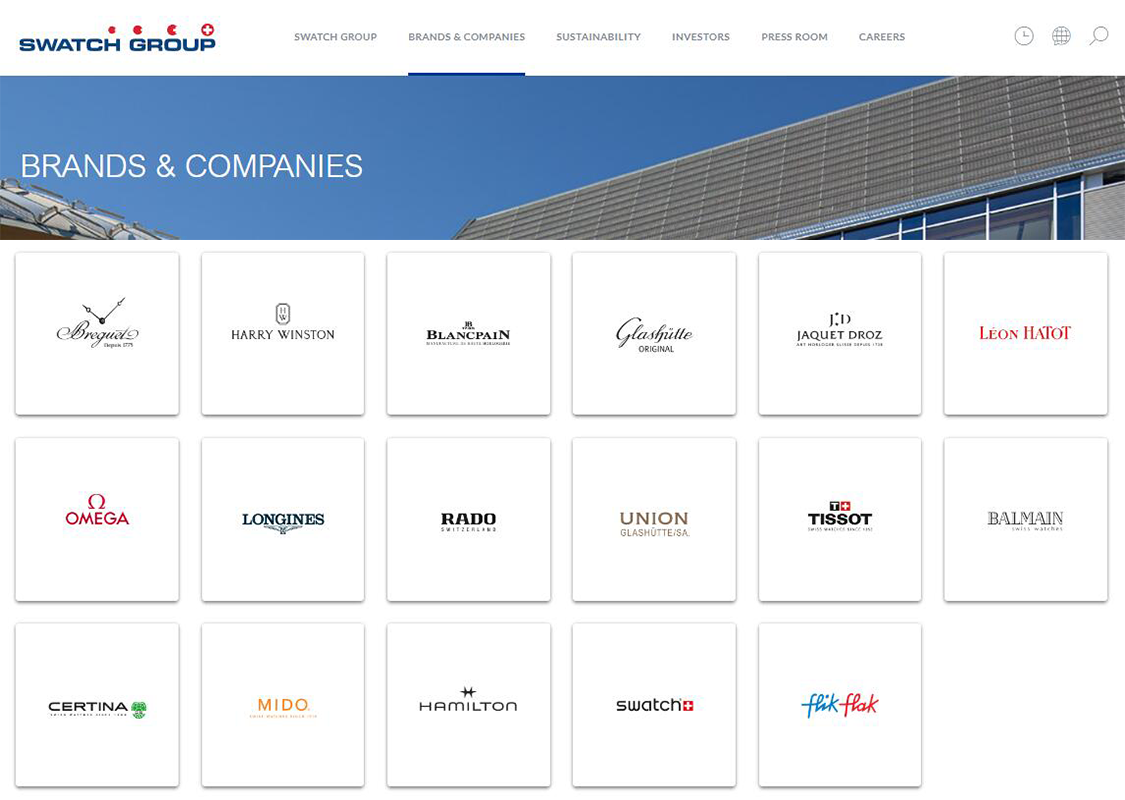 Atiende tanto a consumidores preocupados por la moda como a consumidores orientados a los deportes, ofreciendo una combinación de precios y estilos.
Atiende tanto a consumidores preocupados por la moda como a consumidores orientados a los deportes, ofreciendo una combinación de precios y estilos.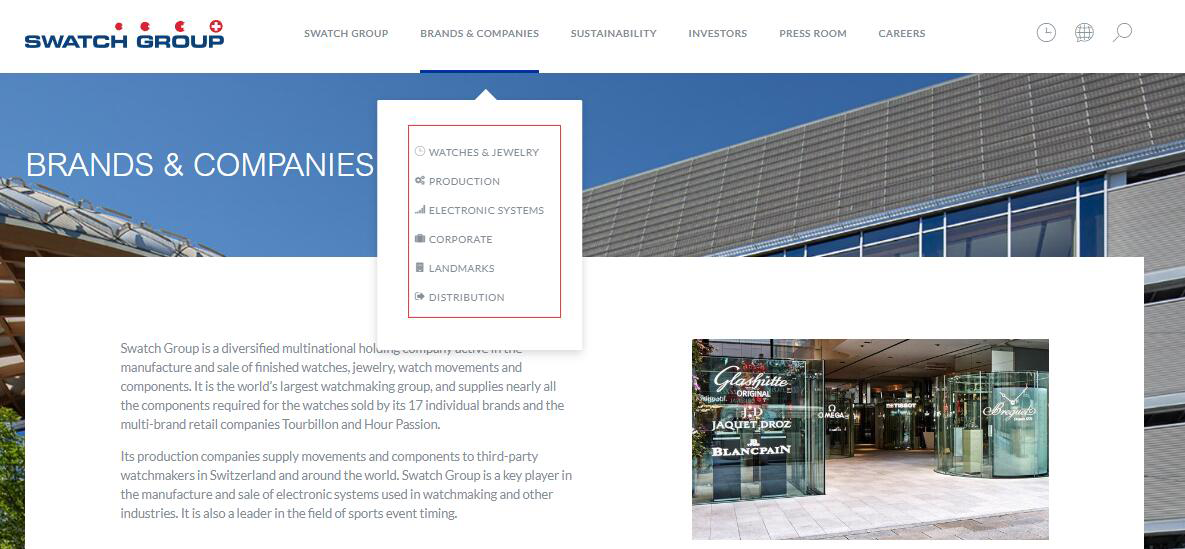
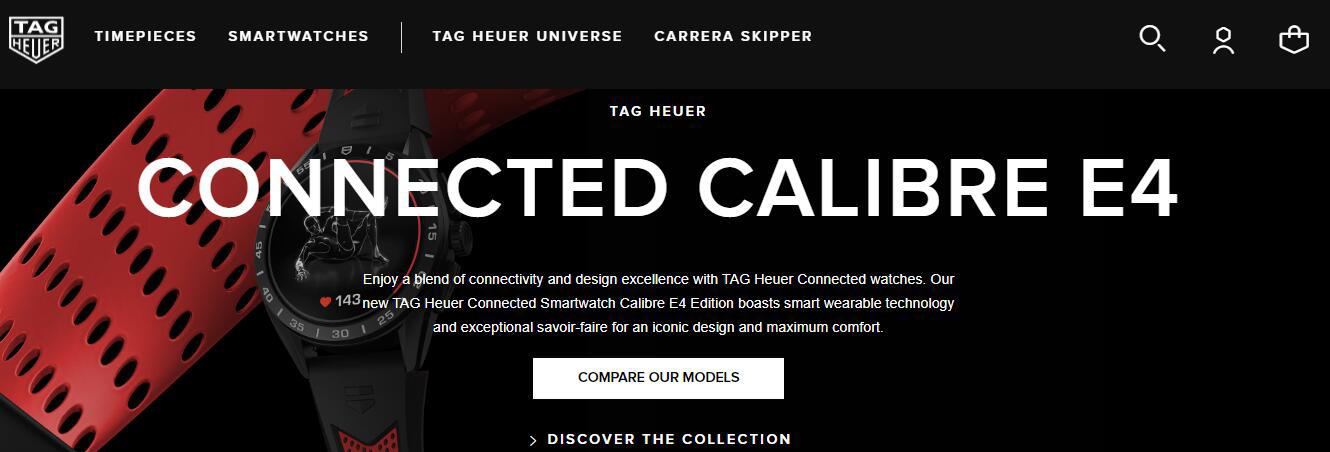
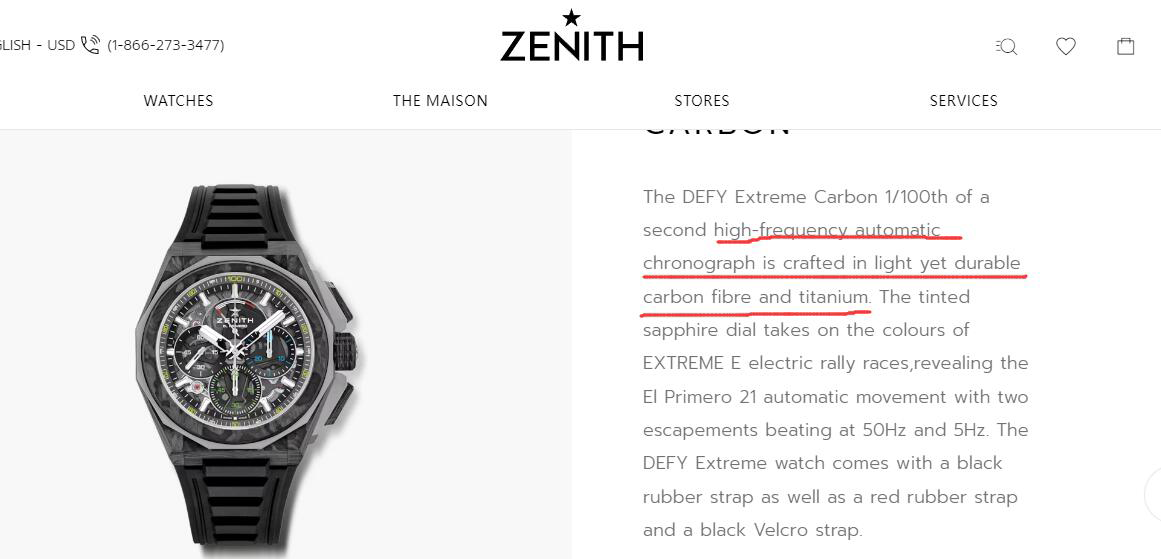
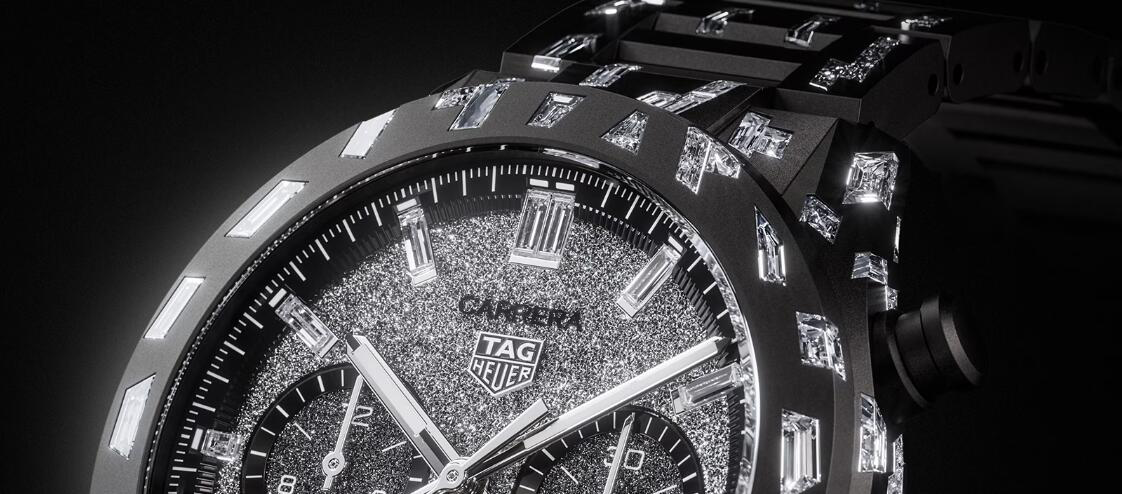

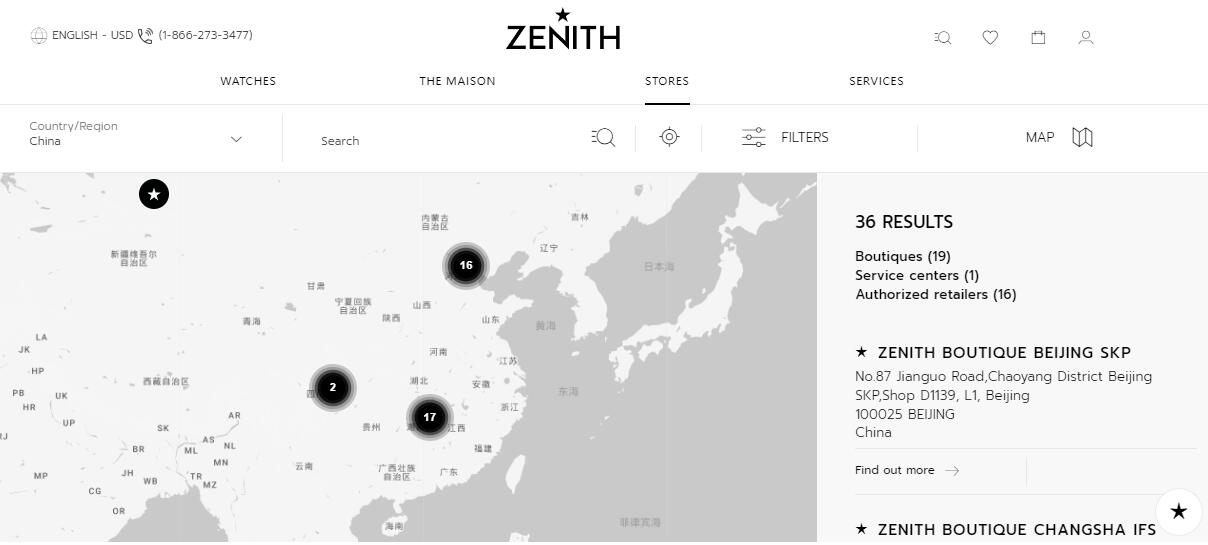
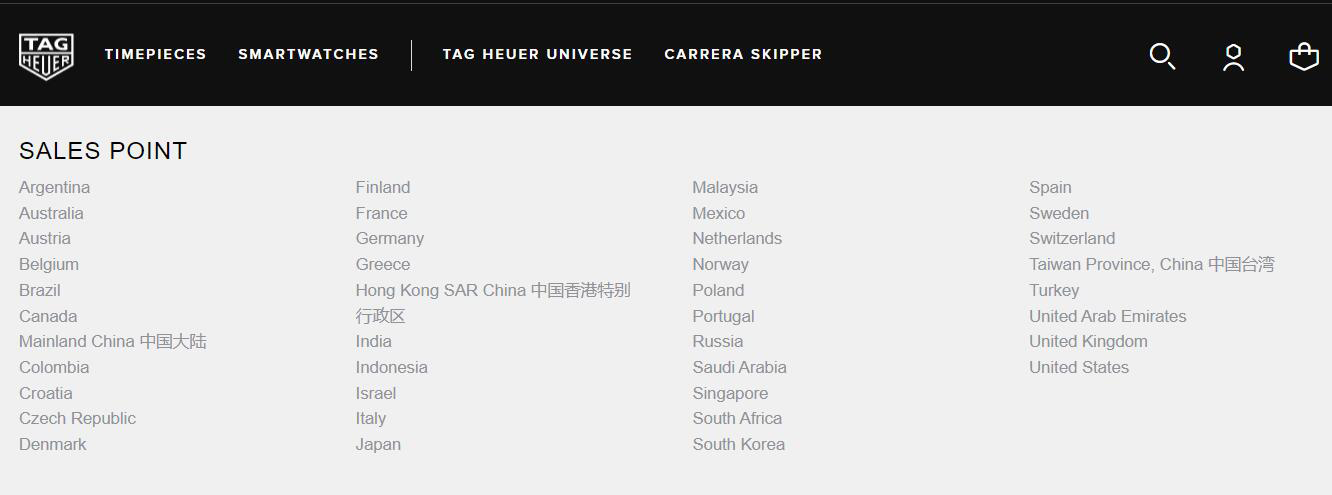
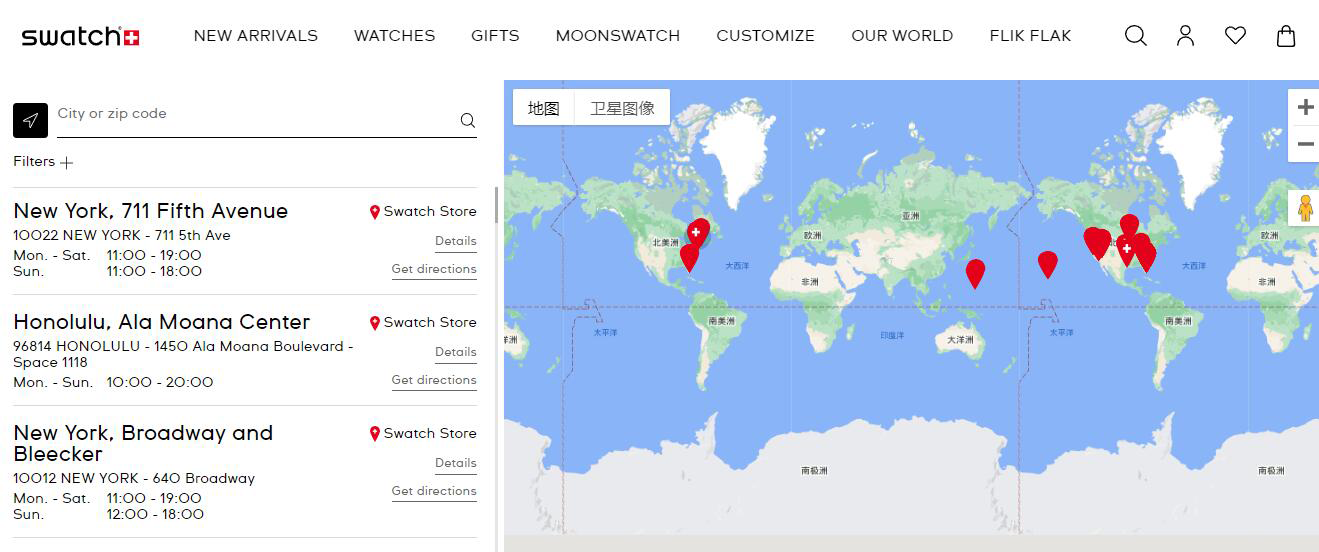
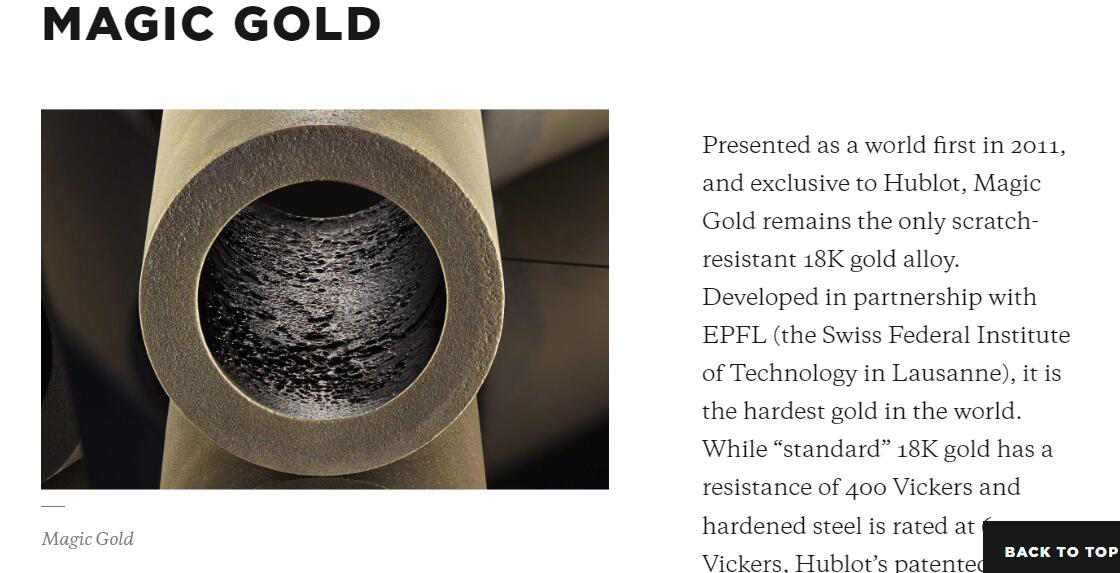
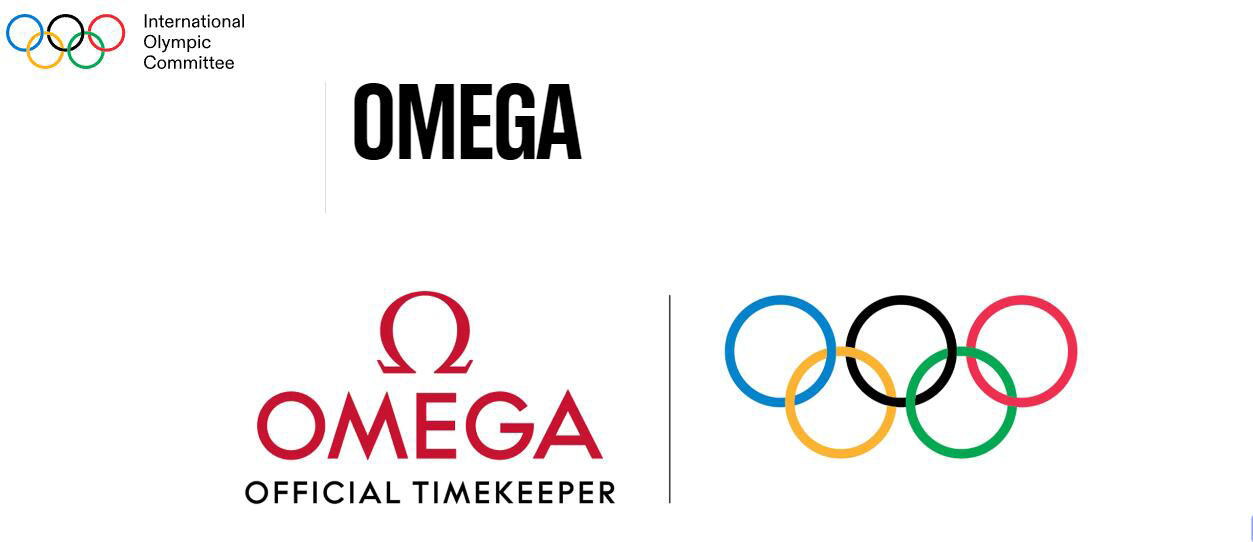
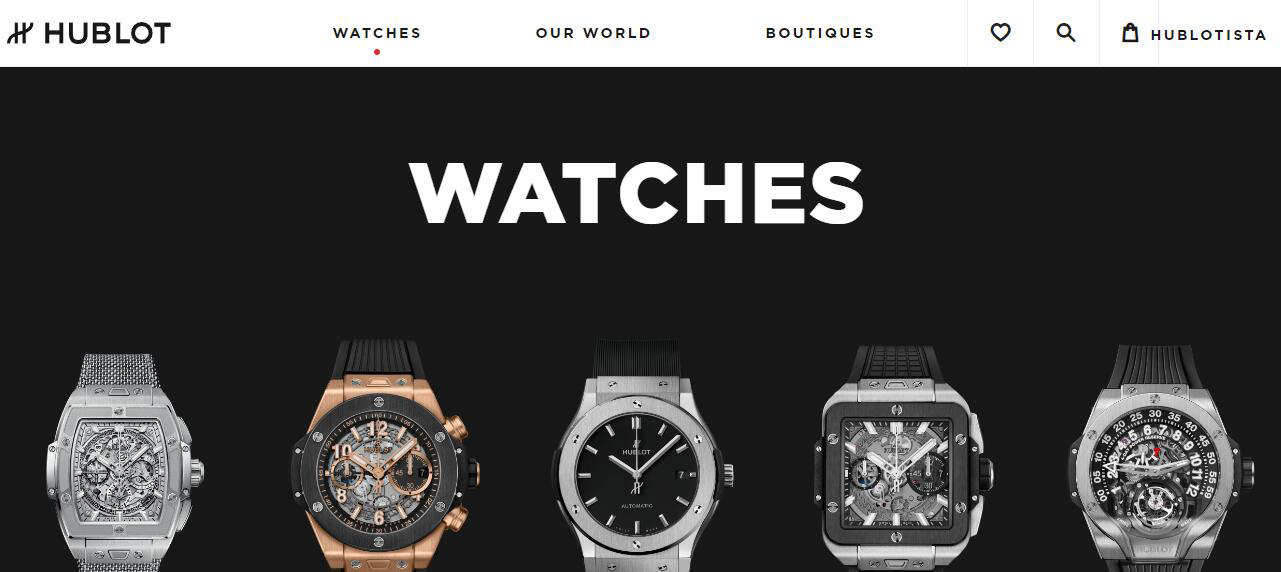

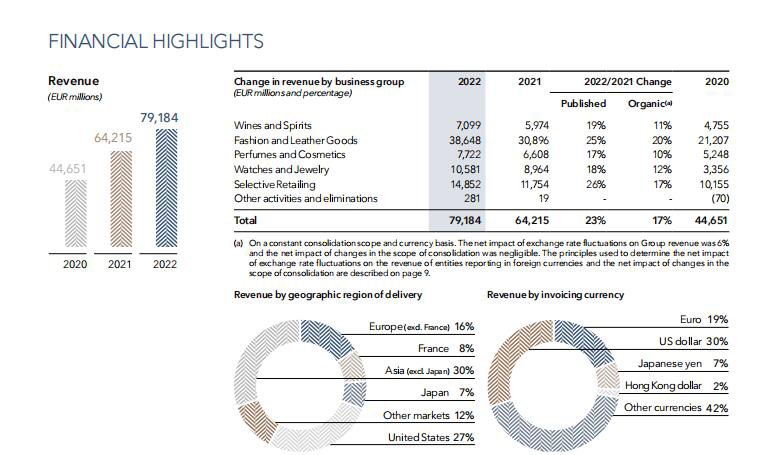
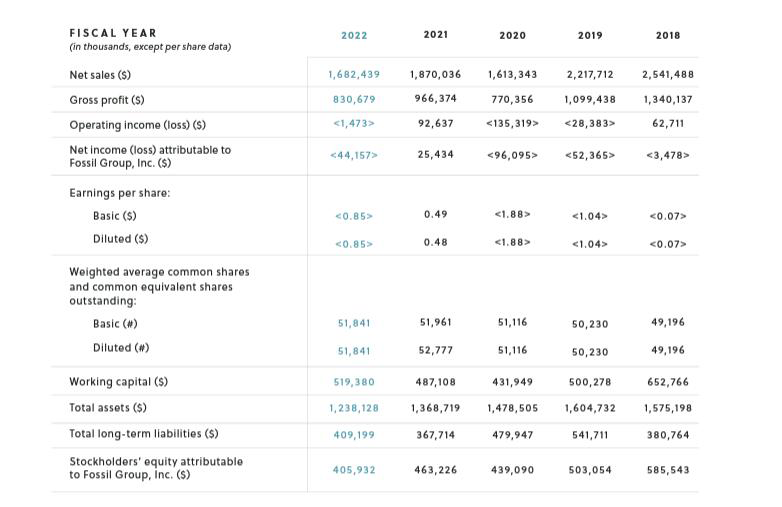
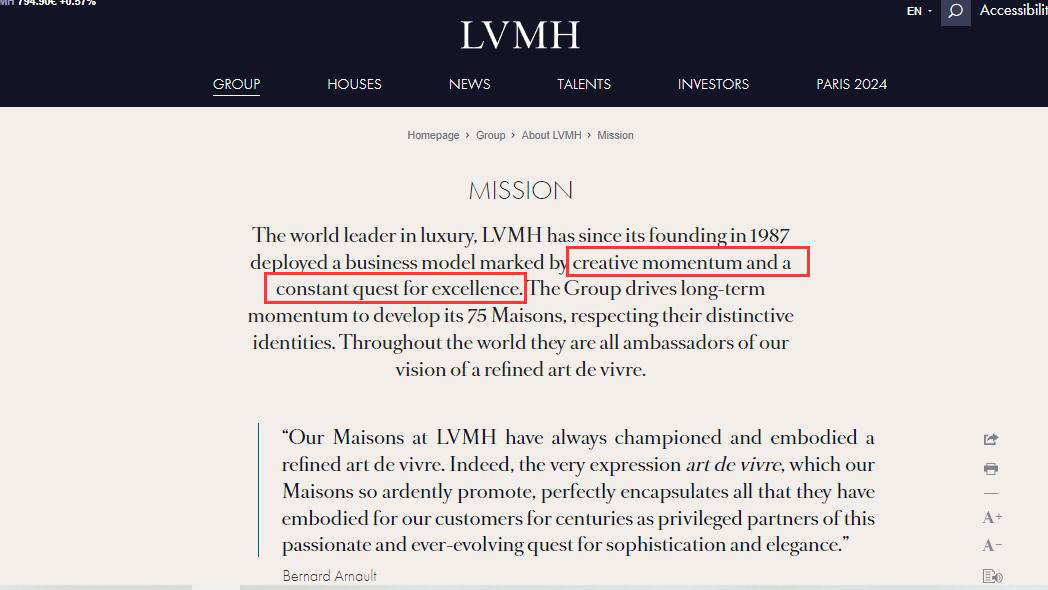
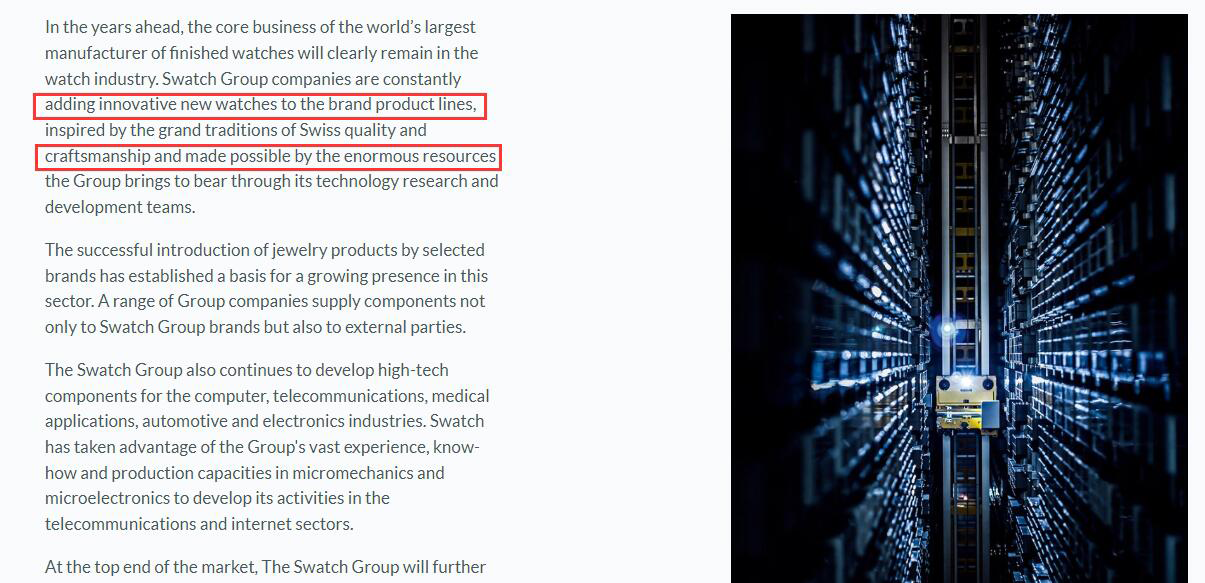
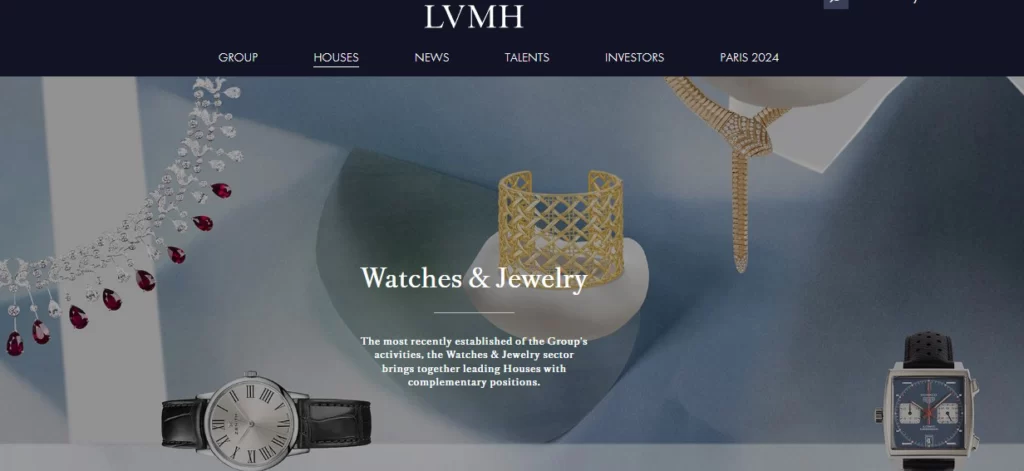
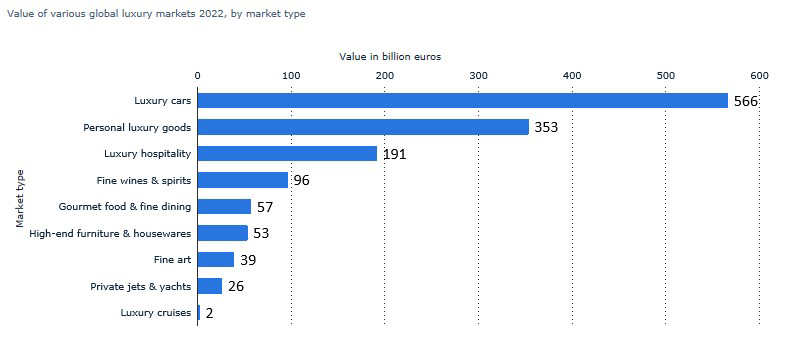
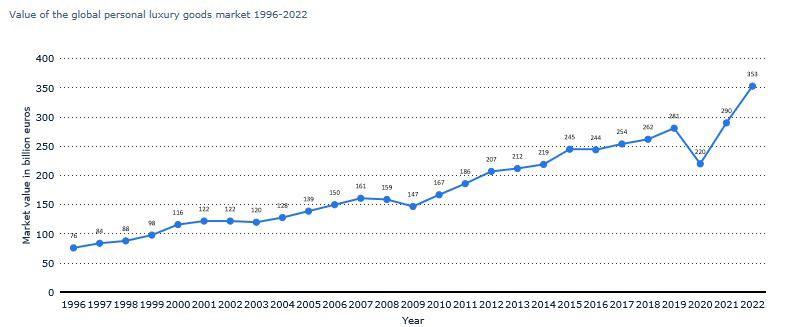
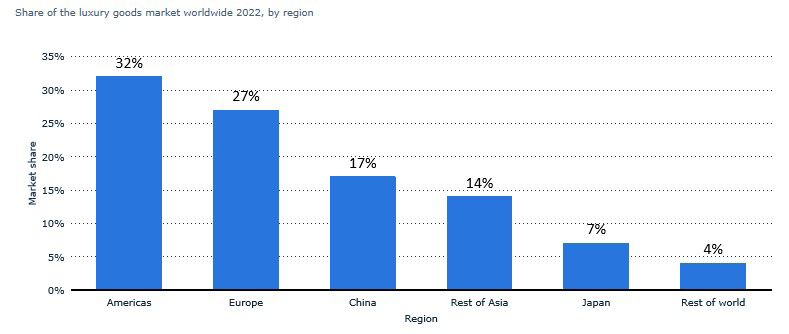
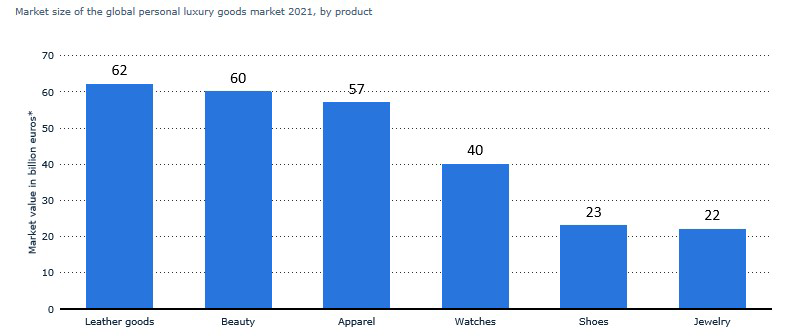

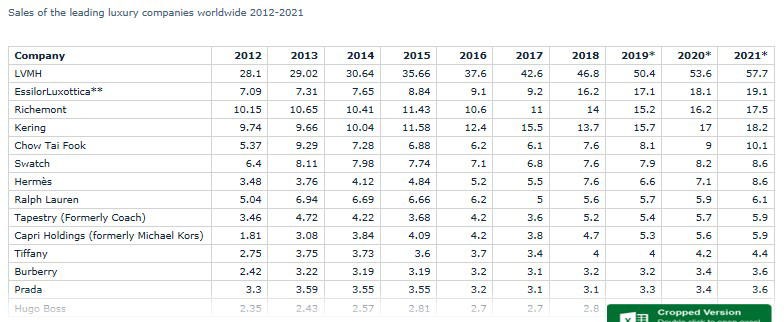
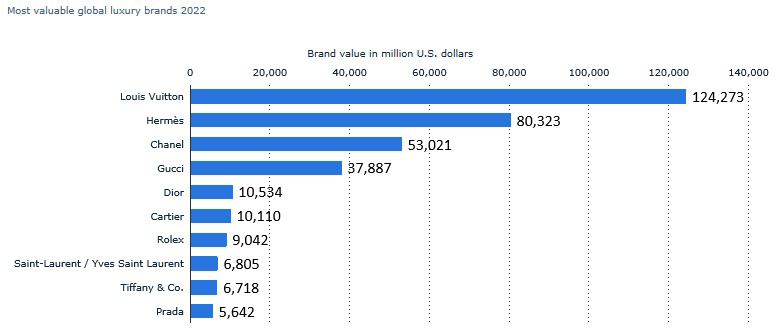
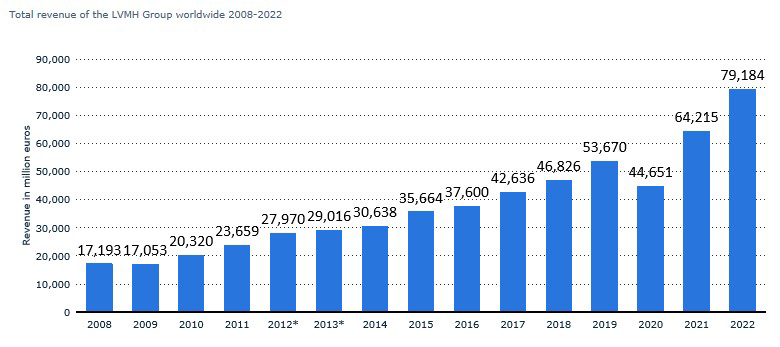
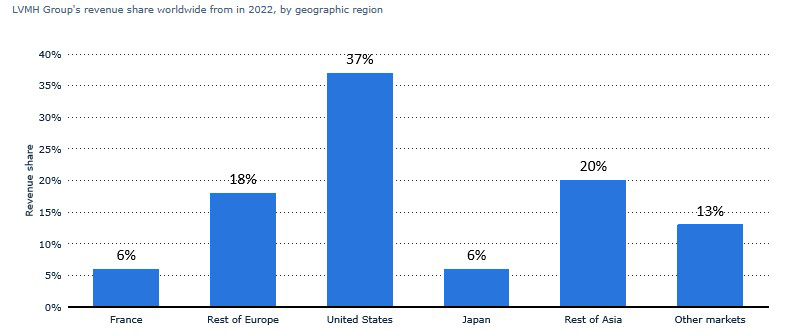

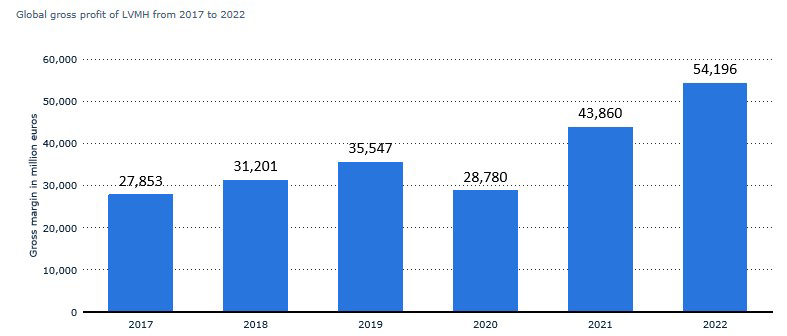
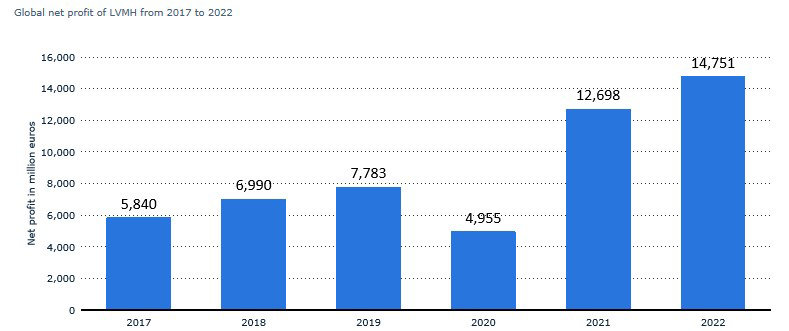
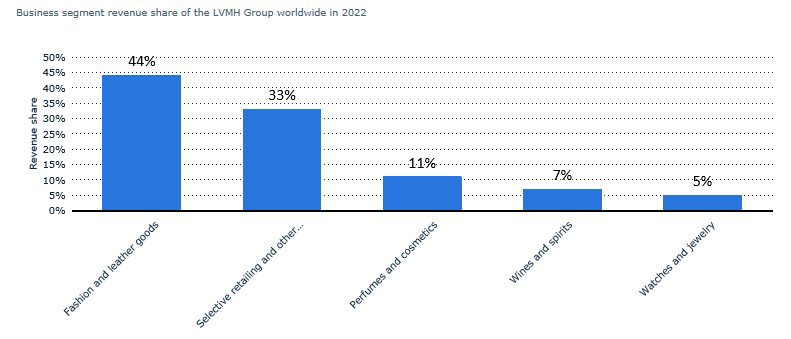
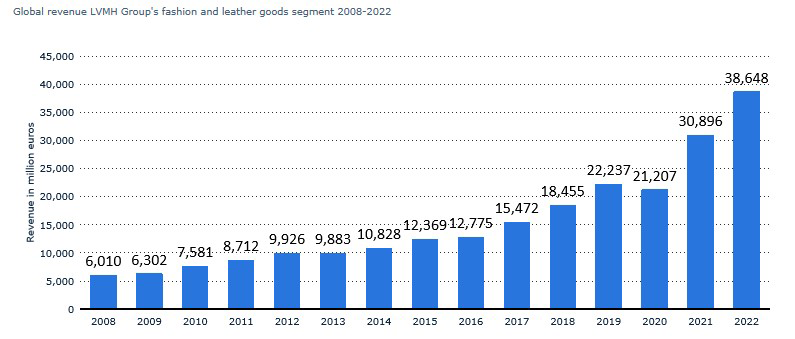
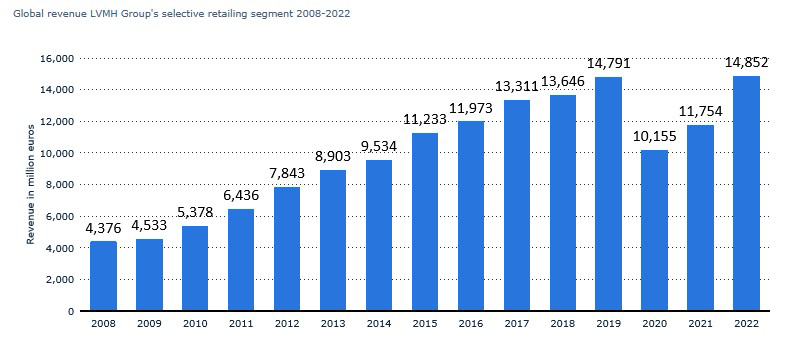
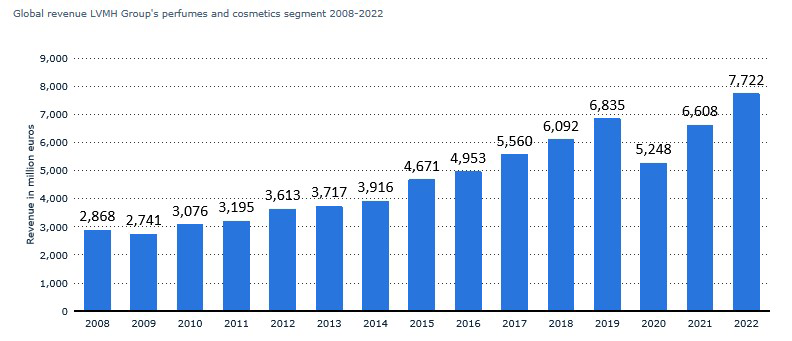
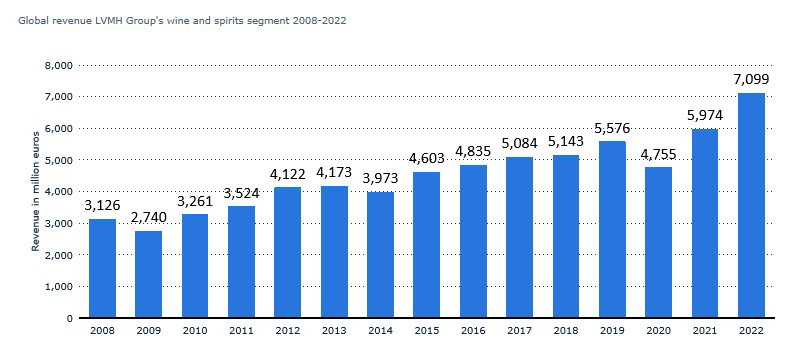
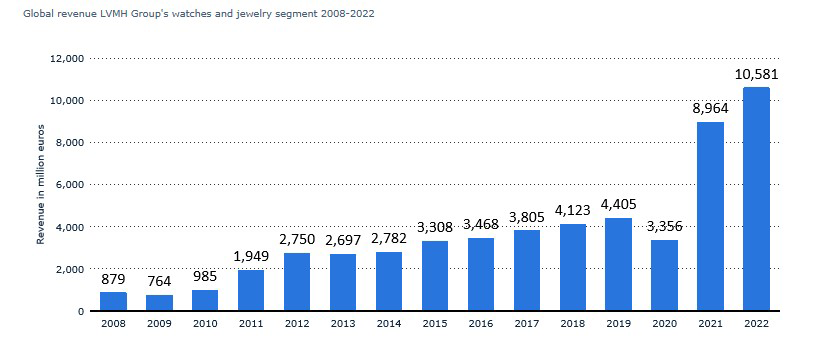
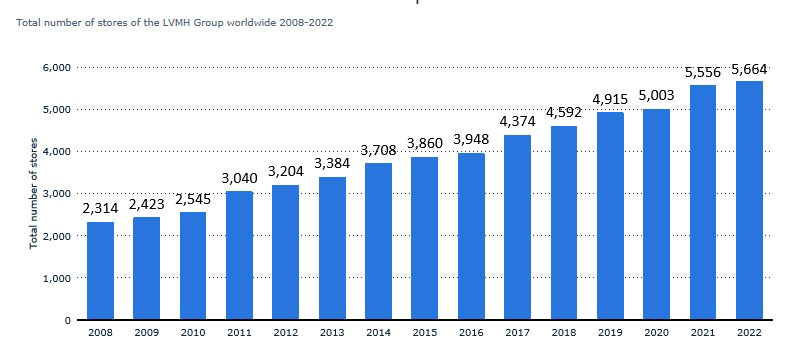
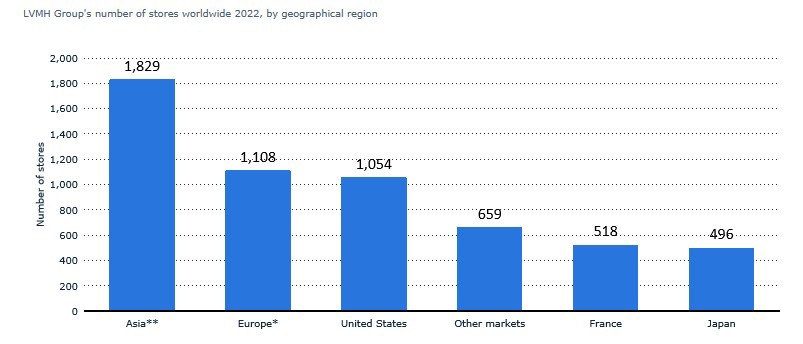
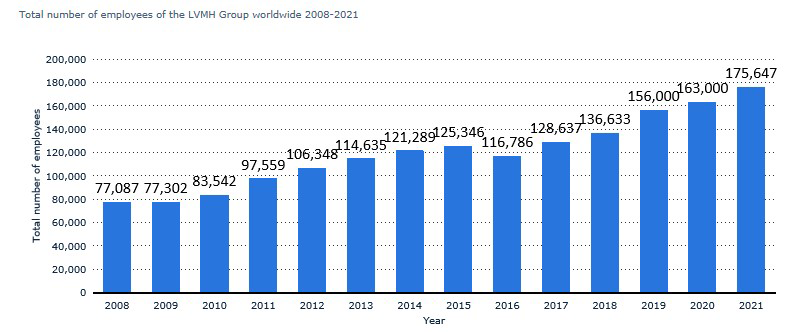
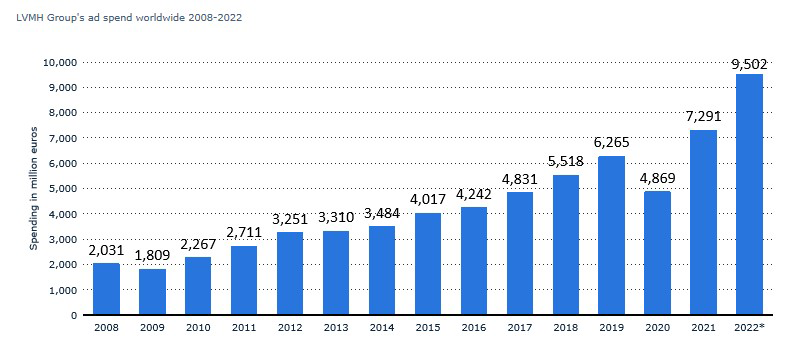
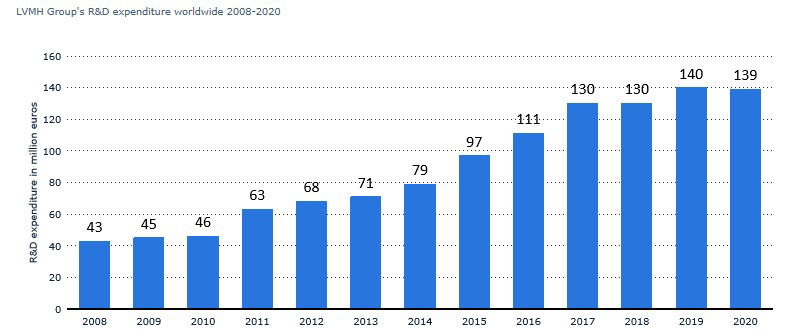
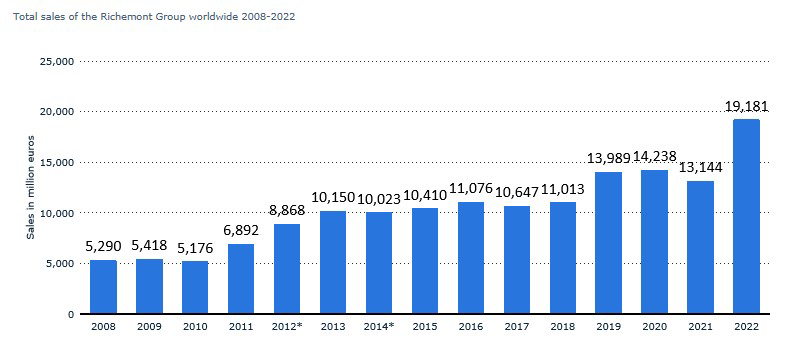
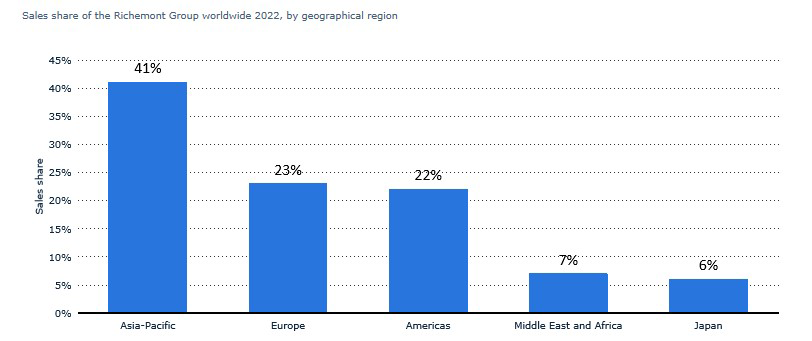
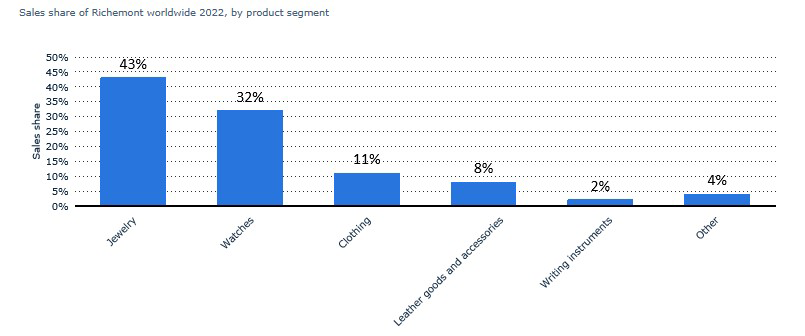
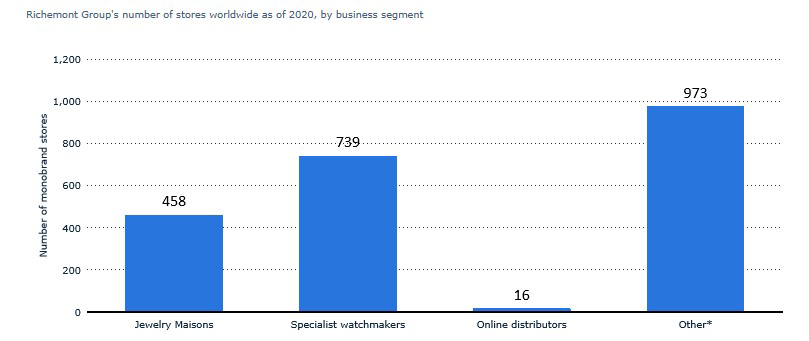
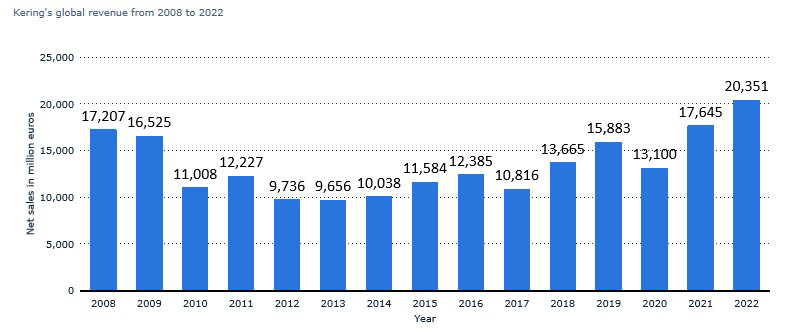
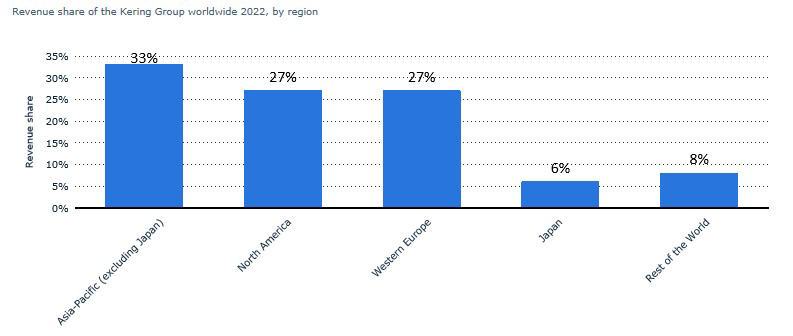

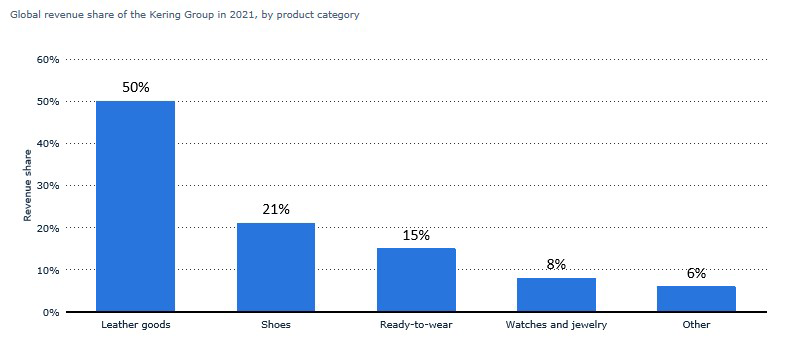
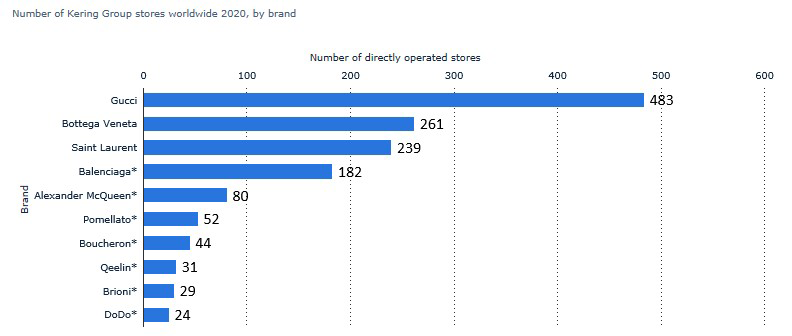
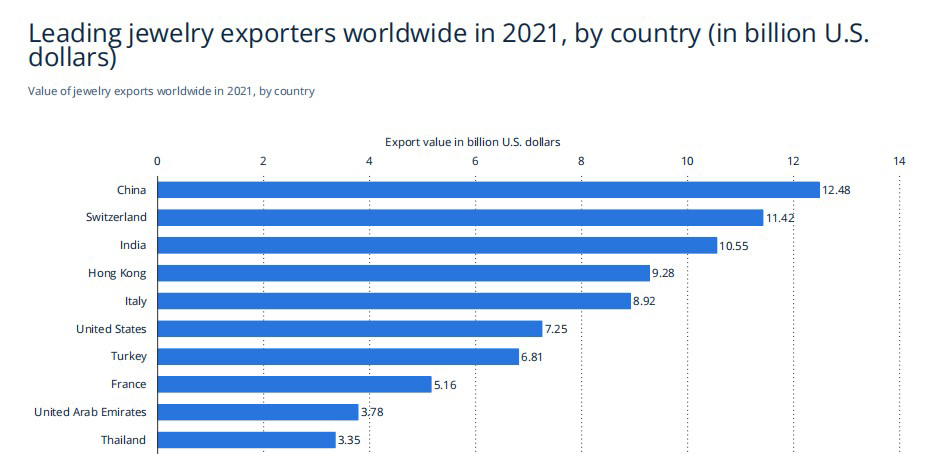
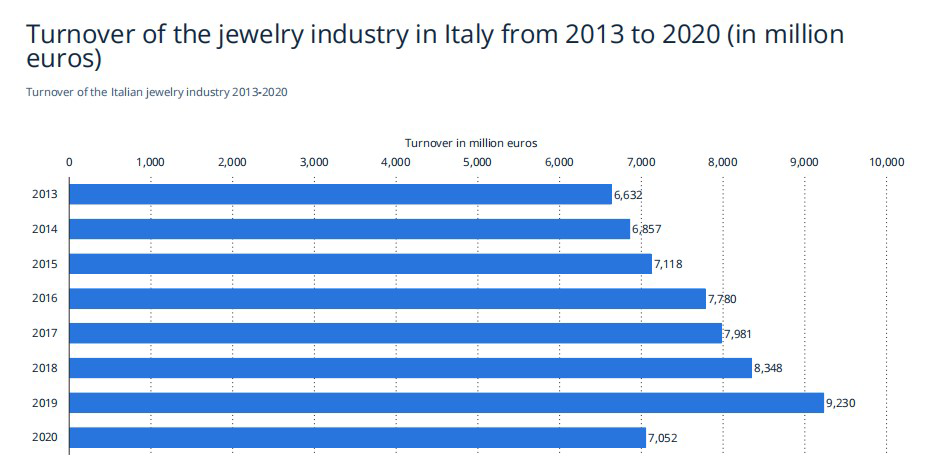
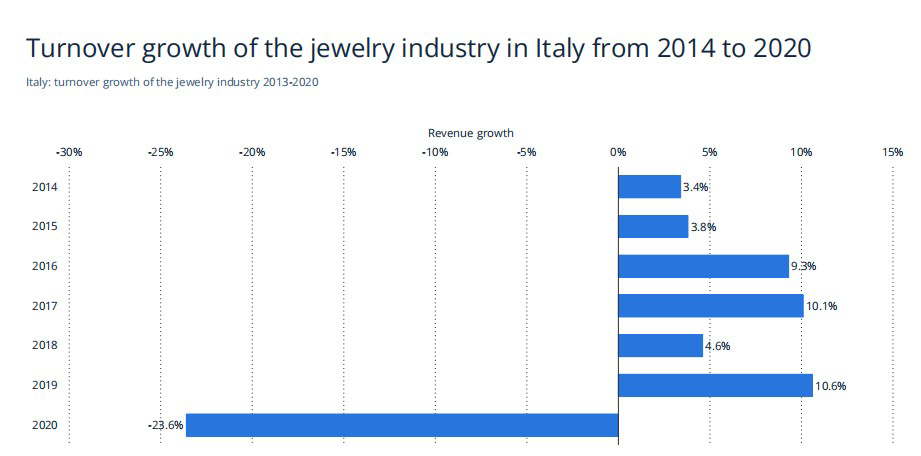
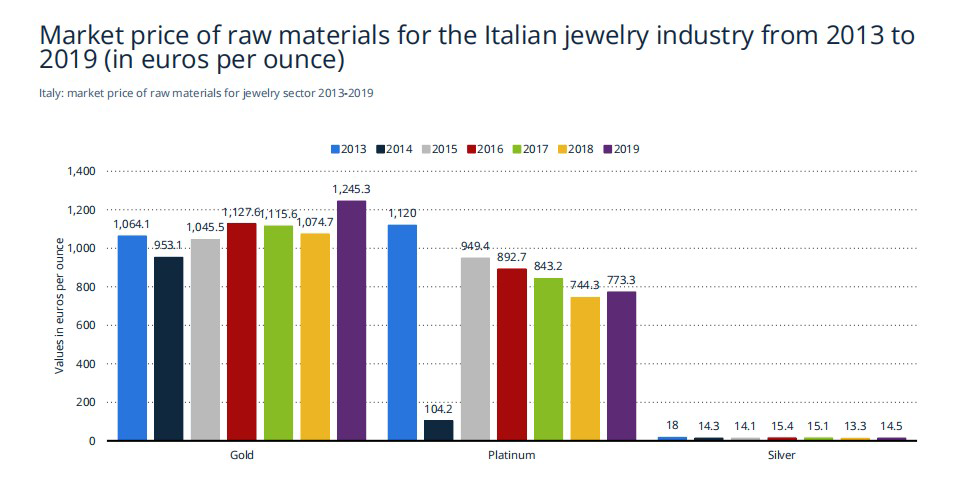
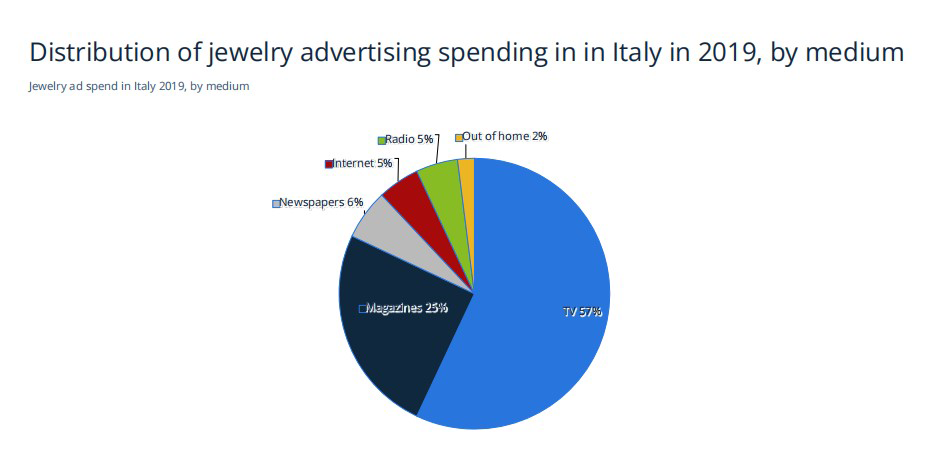

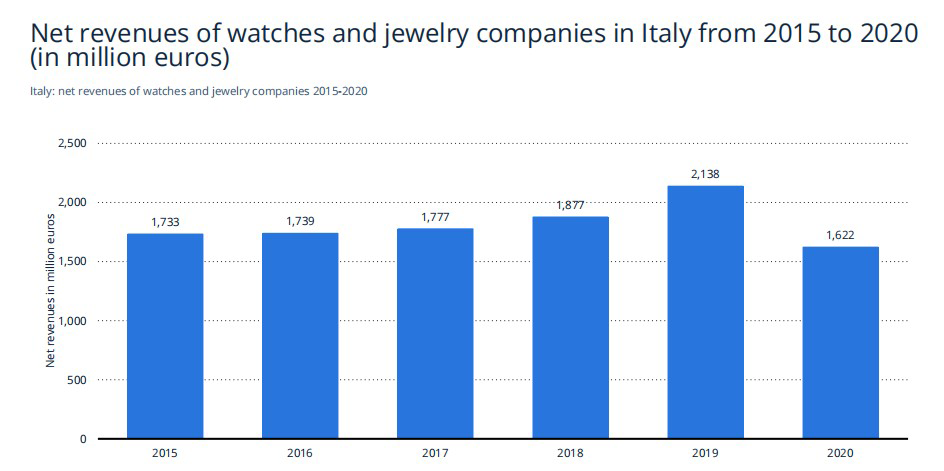
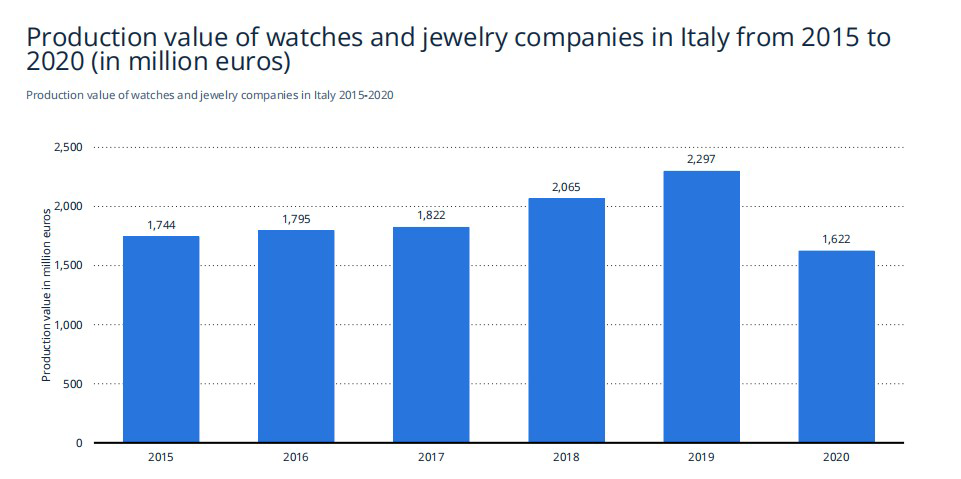
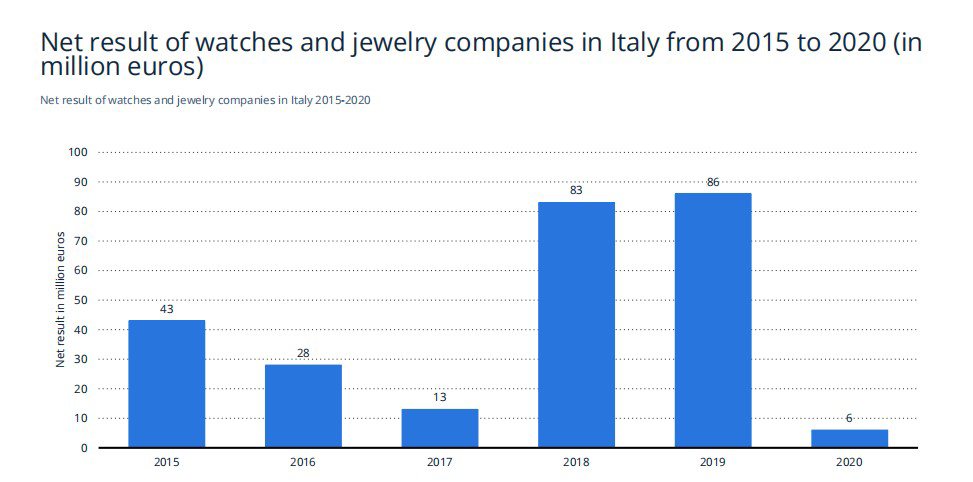
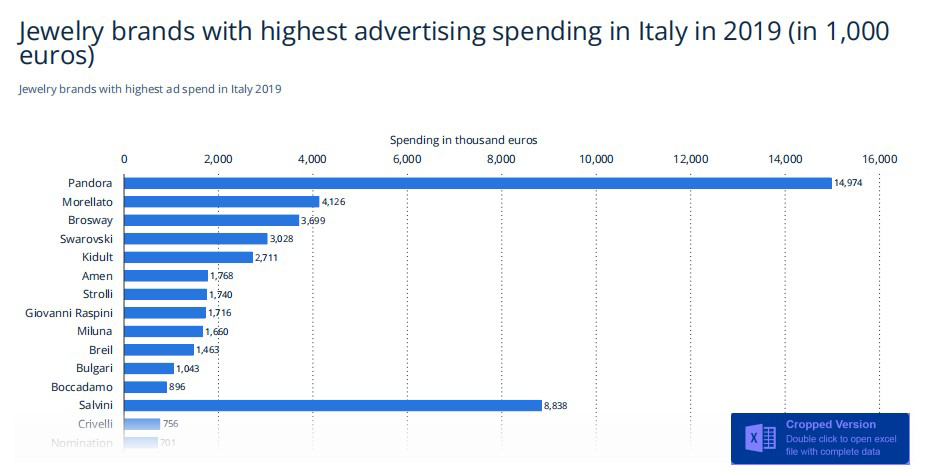
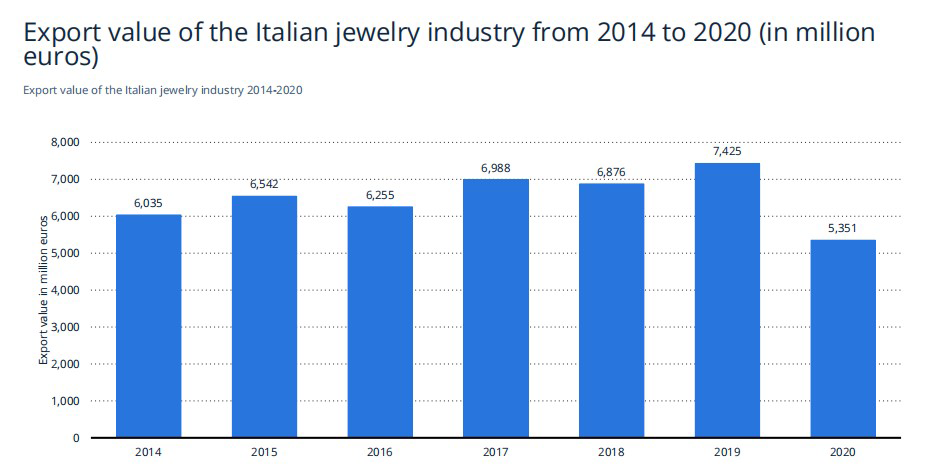
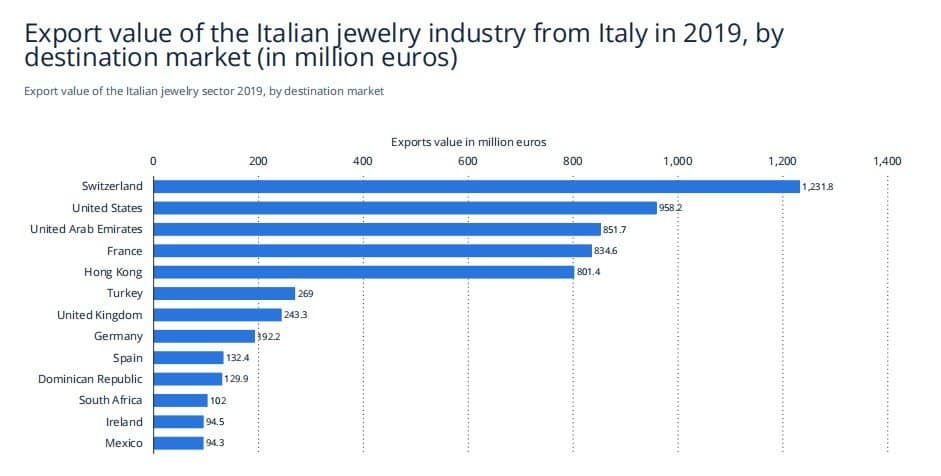
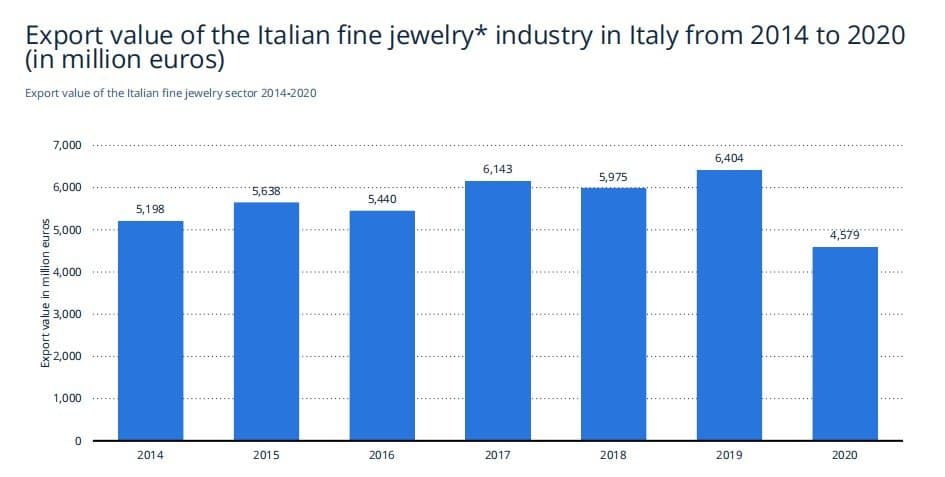
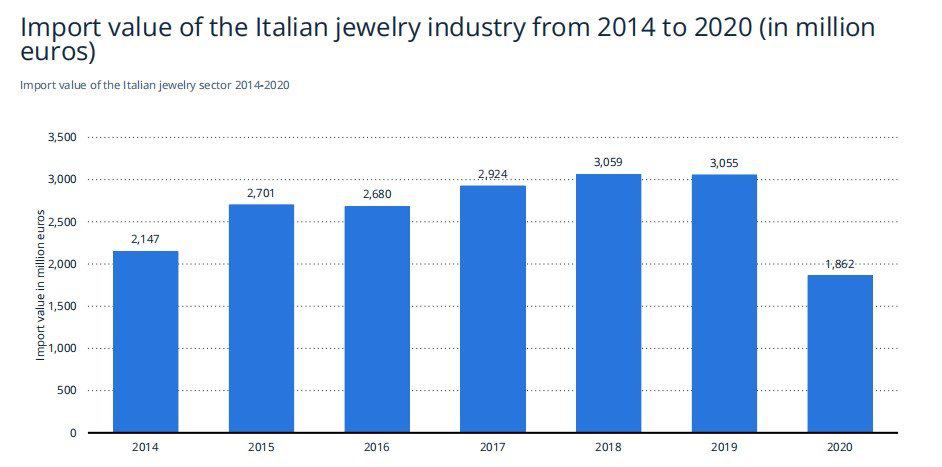
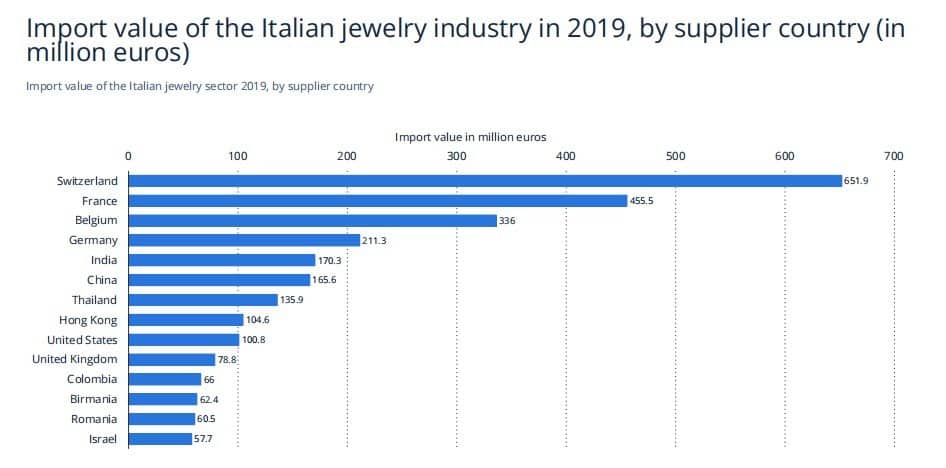
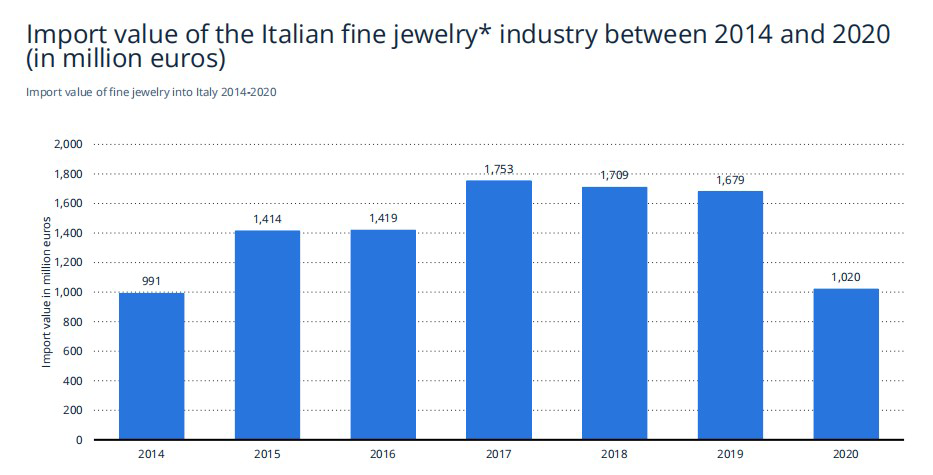
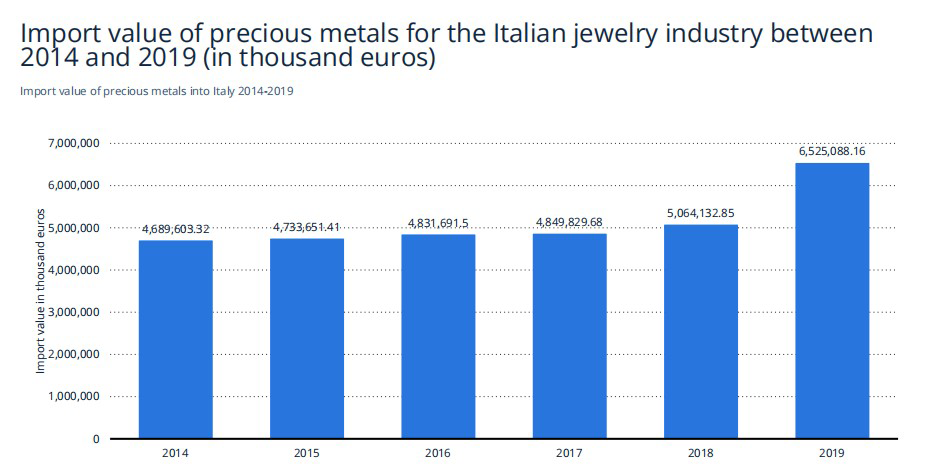

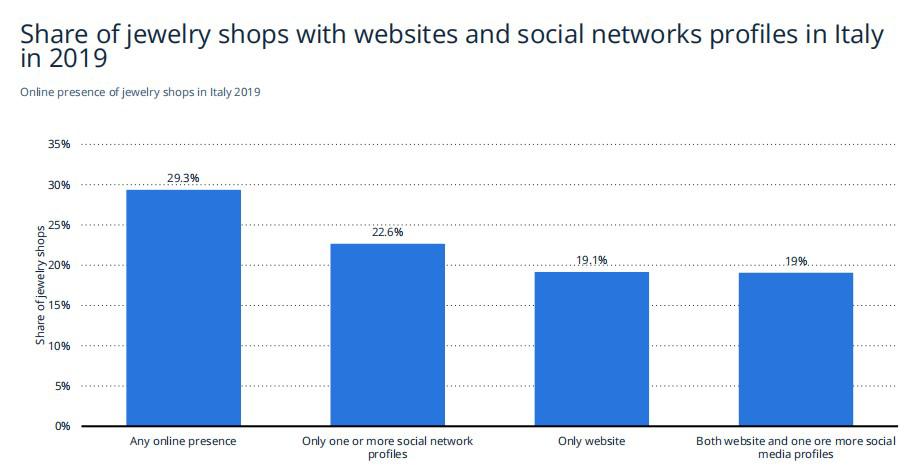
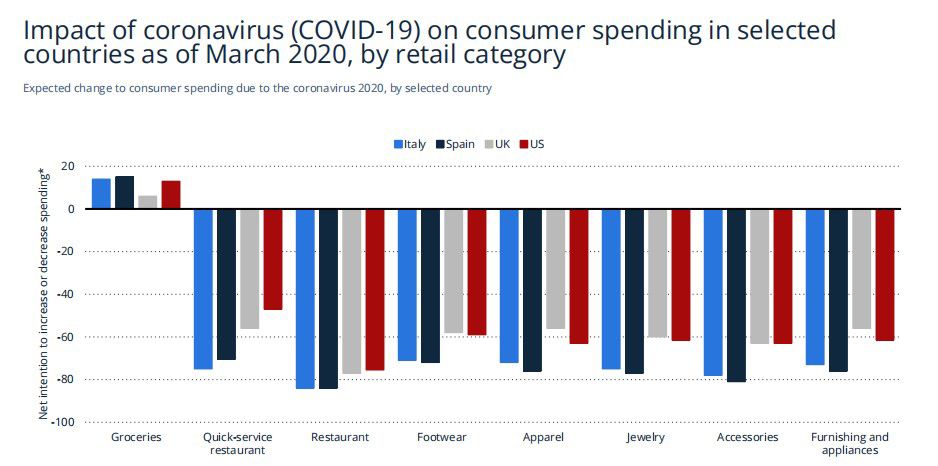
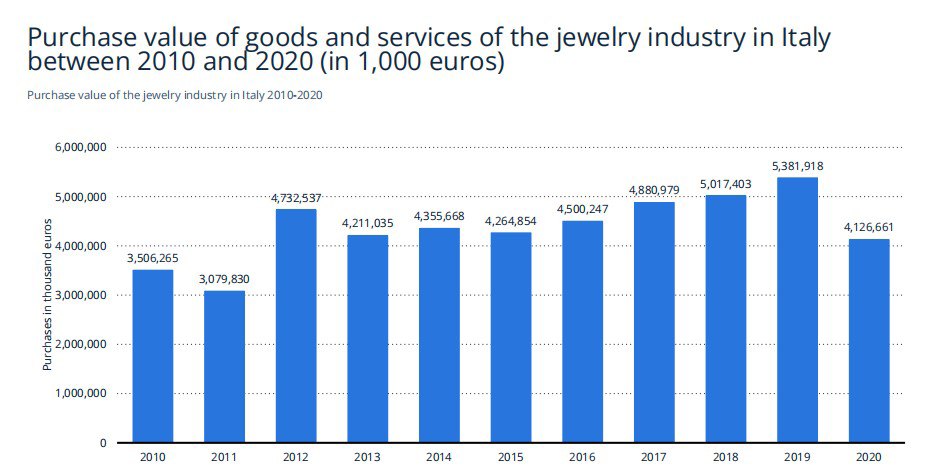















































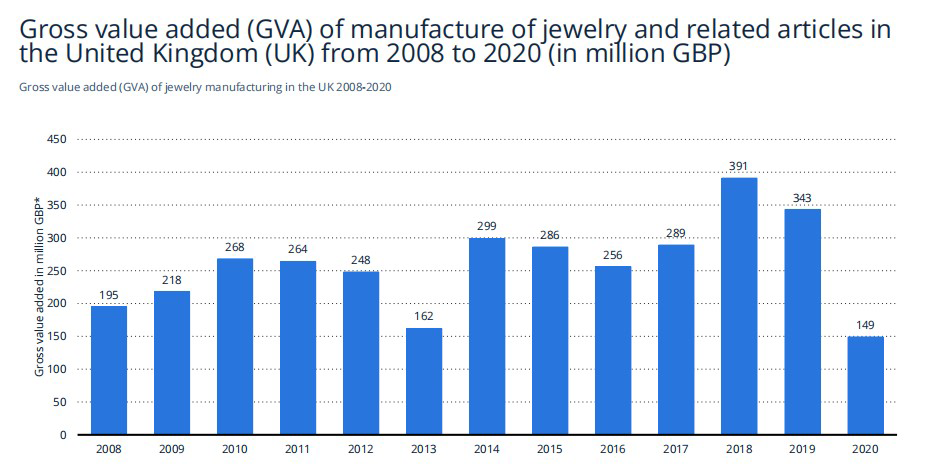



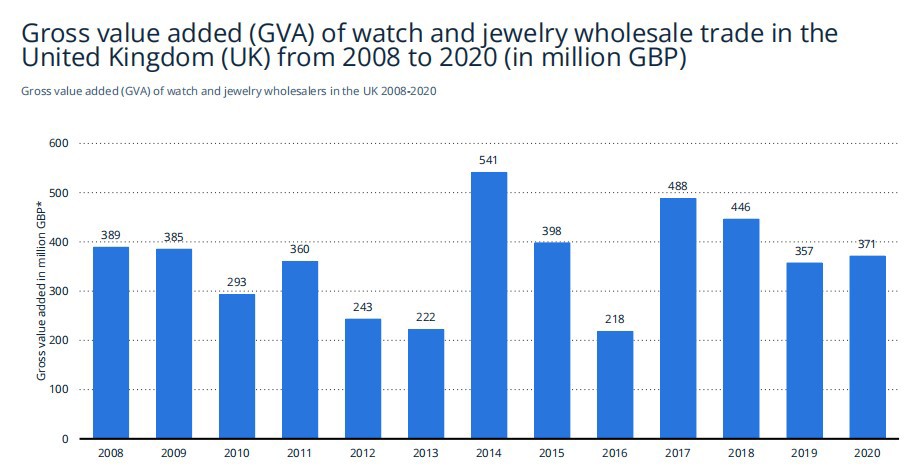






















 Descripción: El número de empresas en la industria de fabricación de calzado en Polonia disminuyó a 1.472 empresas respecto al año anterior. Esto marca el número más bajo de empresas en esta industria durante el período observado.
Descripción: El número de empresas en la industria de fabricación de calzado en Polonia disminuyó a 1.472 empresas respecto al año anterior. Esto marca el número más bajo de empresas en esta industria durante el período observado.  Descripción: El número de empleados en la industria de confección en Polonia se redujo en 2020 a 69.678 empleados. En 2020, el número de empleados alcanzó su valor más bajo de los últimos años.
Descripción: El número de empleados en la industria de confección en Polonia se redujo en 2020 a 69.678 empleados. En 2020, el número de empleados alcanzó su valor más bajo de los últimos años. Descripción: El número de empleados en la industria de fabricación de calzado en Polonia disminuyó en 2020 en 3.146 empleados (-18,18 por ciento) en comparación con el año anterior. Esto marca el número más bajo de empleados en esta industria durante el período observado.
Descripción: El número de empleados en la industria de fabricación de calzado en Polonia disminuyó en 2020 en 3.146 empleados (-18,18 por ciento) en comparación con el año anterior. Esto marca el número más bajo de empleados en esta industria durante el período observado. Descripción: En 2022 se produjeron en Polonia más de 2,1 millones de unidades de pantalones, monos, calzones y pantalones cortos para hombres y niños. Se trata de 1.201 mil unidades más que la producción de pantalones, monos, calzones y shorts para mujeres.
Descripción: En 2022 se produjeron en Polonia más de 2,1 millones de unidades de pantalones, monos, calzones y pantalones cortos para hombres y niños. Se trata de 1.201 mil unidades más que la producción de pantalones, monos, calzones y shorts para mujeres.  Descripción: En 2020, el valor de la producción de la industria de confección en Polonia se mantuvo prácticamente sin cambios en alrededor de 2.300 millones de euros.
Descripción: En 2020, el valor de la producción de la industria de confección en Polonia se mantuvo prácticamente sin cambios en alrededor de 2.300 millones de euros. Descripción: En 2022 se produjeron en Polonia casi 20,5 millones de pares de zapatos, lo que representó una disminución de más del cinco por ciento en comparación con el año anterior.
Descripción: En 2022 se produjeron en Polonia casi 20,5 millones de pares de zapatos, lo que representó una disminución de más del cinco por ciento en comparación con el año anterior.  Descripción: El volumen de cuero producido en Polonia disminuyó durante el período analizado. En 2022 se produjeron cerca de 5,7 mil toneladas métricas de cuero.
Descripción: El volumen de cuero producido en Polonia disminuyó durante el período analizado. En 2022 se produjeron cerca de 5,7 mil toneladas métricas de cuero. Descripción: Entre 2015 y 2019, el valor de mercado de la ropa y el calzado ha aumentado de manera constante. Se estima que el mercado caerá un 16,3 por ciento en 2020 debido a la pandemia de COVID-19. Sin embargo, en 2021 se prevé que aumente hasta los 37,6 mil millones de zloty.
Descripción: Entre 2015 y 2019, el valor de mercado de la ropa y el calzado ha aumentado de manera constante. Se estima que el mercado caerá un 16,3 por ciento en 2020 debido a la pandemia de COVID-19. Sin embargo, en 2021 se prevé que aumente hasta los 37,6 mil millones de zloty.  Descripción: Los resultados financieros netos del sector de la confección aumentaron en Polonia en el período observado un 15,1 por ciento. En 2022, ascendió a más de 309 millones de PLN.
Descripción: Los resultados financieros netos del sector de la confección aumentaron en Polonia en el período observado un 15,1 por ciento. En 2022, ascendió a más de 309 millones de PLN. Descripción: En 2021 aumentó el intercambio de bienes en el mercado de la confección en Polonia. El valor de las importaciones aumentó casi un 21 por ciento en comparación con el año anterior, mientras que el valor de las exportaciones aumentó casi un 27 por ciento.
Descripción: En 2021 aumentó el intercambio de bienes en el mercado de la confección en Polonia. El valor de las importaciones aumentó casi un 21 por ciento en comparación con el año anterior, mientras que el valor de las exportaciones aumentó casi un 27 por ciento.  Descripción: En 2021, Pakistán fue el principal proveedor de prendas de vestir a Polonia, con importaciones valoradas en aproximadamente 20,6 millones de dólares estadounidenses. India ocupó el segundo lugar, con importaciones a Polonia por un valor aproximado de 13 millones de dólares estadounidenses.
Descripción: En 2021, Pakistán fue el principal proveedor de prendas de vestir a Polonia, con importaciones valoradas en aproximadamente 20,6 millones de dólares estadounidenses. India ocupó el segundo lugar, con importaciones a Polonia por un valor aproximado de 13 millones de dólares estadounidenses.  Descripción: En 2021, Alemania fue el principal país exportador de prendas de vestir en Polonia, con exportaciones valoradas en aproximadamente 25 millones de dólares estadounidenses. España ocupó el segundo lugar, con exportaciones de Polonia por valor de unos tres millones de dólares estadounidenses.
Descripción: En 2021, Alemania fue el principal país exportador de prendas de vestir en Polonia, con exportaciones valoradas en aproximadamente 25 millones de dólares estadounidenses. España ocupó el segundo lugar, con exportaciones de Polonia por valor de unos tres millones de dólares estadounidenses.  Descripción: En 2021 aumentó el intercambio de mercancías en el mercado del calzado en Polonia. El valor de las importaciones aumentó más del 11 por ciento en comparación con el año anterior, mientras que el valor de las exportaciones aumentó más del 14 por ciento.
Descripción: En 2021 aumentó el intercambio de mercancías en el mercado del calzado en Polonia. El valor de las importaciones aumentó más del 11 por ciento en comparación con el año anterior, mientras que el valor de las exportaciones aumentó más del 14 por ciento.  Descripción: En 2021, el mayor exportador de calzado, sombrerería, etc. a Polonia fue China. El valor de las importaciones procedentes de China ascendió a más de 1,33 mil millones de euros. Por otro lado, la exportación más importante de calzado y sombrerería de Polonia fue a Alemania.
Descripción: En 2021, el mayor exportador de calzado, sombrerería, etc. a Polonia fue China. El valor de las importaciones procedentes de China ascendió a más de 1,33 mil millones de euros. Por otro lado, la exportación más importante de calzado y sombrerería de Polonia fue a Alemania. Descripción: En 2021 aumentó el intercambio de mercancías en el mercado de bolsos en Polonia. El valor de las importaciones aumentó más del 17,3 por ciento en comparación con el año anterior, mientras que el valor de las exportaciones aumentó un 34,7 por ciento.
Descripción: En 2021 aumentó el intercambio de mercancías en el mercado de bolsos en Polonia. El valor de las importaciones aumentó más del 17,3 por ciento en comparación con el año anterior, mientras que el valor de las exportaciones aumentó un 34,7 por ciento.  Descripción: En 2021 aumentó el intercambio de bienes en el mercado del cuero en Polonia. El valor de las importaciones aumentó un 16 por ciento en comparación con el año anterior, mientras que el valor de las exportaciones también creció más del 11 por ciento.
Descripción: En 2021 aumentó el intercambio de bienes en el mercado del cuero en Polonia. El valor de las importaciones aumentó un 16 por ciento en comparación con el año anterior, mientras que el valor de las exportaciones también creció más del 11 por ciento.  Descripción:
Descripción:  Descripción: En 2021, el número de tiendas minoristas de calzado y artículos de cuero en Polonia disminuyó un 4,2 por ciento en comparación con el año anterior.
Descripción: En 2021, el número de tiendas minoristas de calzado y artículos de cuero en Polonia disminuyó un 4,2 por ciento en comparación con el año anterior.  Descripción: En 2022, el 24 por ciento de los encuestados en Polonia compraron ropa o calzado de la marca Reserved. h&Le siguió la cadena M con un 23 por ciento.
Descripción: En 2022, el 24 por ciento de los encuestados en Polonia compraron ropa o calzado de la marca Reserved. h&Le siguió la cadena M con un 23 por ciento.  Descripción: En 2022, H.&M en Polonia fue visitado con más frecuencia por mujeres (27 por ciento) que por hombres (15 por ciento).
Descripción: En 2022, H.&M en Polonia fue visitado con más frecuencia por mujeres (27 por ciento) que por hombres (15 por ciento).  Descripción:
Descripción:  Descripción: En 2022, la tienda de calzado online eobuwie.pl encabezó el ranking de tiendas online de ropa y calzado en Polonia, alcanzando casi 56 puntos en esta categoría.
Descripción: En 2022, la tienda de calzado online eobuwie.pl encabezó el ranking de tiendas online de ropa y calzado en Polonia, alcanzando casi 56 puntos en esta categoría.  Descripción: El gasto de los polacos en ropa y calzado aumentó durante el período observado. En 2021, los consumidores gastaron casi 58 zloty al mes en estos productos.
Descripción: El gasto de los polacos en ropa y calzado aumentó durante el período observado. En 2021, los consumidores gastaron casi 58 zloty al mes en estos productos.  Descripción: En 2018, el sector de fabricación de prendas de vestir registró el mayor retorno de las ventas bruto y neto, con una proporción del 9,1 y el 7,9 por ciento, respectivamente. En 2022, el indicador de rentabilidad neta del volumen de negocios disminuyó respecto al año anterior, alcanzando el siete por ciento.
Descripción: En 2018, el sector de fabricación de prendas de vestir registró el mayor retorno de las ventas bruto y neto, con una proporción del 9,1 y el 7,9 por ciento, respectivamente. En 2022, el indicador de rentabilidad neta del volumen de negocios disminuyó respecto al año anterior, alcanzando el siete por ciento.  Descripción: En 2021, los precios de la ropa y el calzado en Polonia disminuyeron un 0,2 por ciento en comparación con el año anterior. Según la fuente, los precios de la ropa bajaron un 0,5 por ciento y los del calzado aumentaron un 0,8 por ciento.
Descripción: En 2021, los precios de la ropa y el calzado en Polonia disminuyeron un 0,2 por ciento en comparación con el año anterior. Según la fuente, los precios de la ropa bajaron un 0,5 por ciento y los del calzado aumentaron un 0,8 por ciento.  Descripción: En 2021, el índice de ventas minoristas de prendas de vestir, textiles y calzado a precios constantes interanual aumentó un 32 por ciento en comparación con 2020 en Polonia.
Descripción: En 2021, el índice de ventas minoristas de prendas de vestir, textiles y calzado a precios constantes interanual aumentó un 32 por ciento en comparación con 2020 en Polonia.  Descripción: De un total de 1481, en 2021 había 1276 fabricantes de prendas de vestir en Polonia, con 49 empleados o menos.
Descripción: De un total de 1481, en 2021 había 1276 fabricantes de prendas de vestir en Polonia, con 49 empleados o menos.  Descripción: De un total de 818, en 2021 había 635 fabricantes textiles en Polonia, con 49 empleados o menos.
Descripción: De un total de 818, en 2021 había 635 fabricantes textiles en Polonia, con 49 empleados o menos.  Descripción: De un total de 334, en 2021 había 284 fabricantes de artículos de cuero en Polonia, con 49 empleados o menos.
Descripción: De un total de 334, en 2021 había 284 fabricantes de artículos de cuero en Polonia, con 49 empleados o menos.  Descripción: Durante el período analizado, los ingresos de las empresas productoras de prendas de vestir en Polonia fluctuaron. En 2022, estos ingresos ascendieron a aproximadamente 5,3 mil millones de PLN.
Descripción: Durante el período analizado, los ingresos de las empresas productoras de prendas de vestir en Polonia fluctuaron. En 2022, estos ingresos ascendieron a aproximadamente 5,3 mil millones de PLN.  Descripción: En 2022, los ingresos del grupo LPP S.A. alcanzaron más de 15,9 mil millones de zloty en todo el mundo.
Descripción: En 2022, los ingresos del grupo LPP S.A. alcanzaron más de 15,9 mil millones de zloty en todo el mundo.  Descripción: Los ingresos por ventas del segmento de ropa y joyería de VRG Capital Group en Polonia en 2021 ascendieron a casi 1,1 mil millones de zloty. El beneficio neto de la venta de prendas de vestir ascendió a 386 millones de eslotis.
Descripción: Los ingresos por ventas del segmento de ropa y joyería de VRG Capital Group en Polonia en 2021 ascendieron a casi 1,1 mil millones de zloty. El beneficio neto de la venta de prendas de vestir ascendió a 386 millones de eslotis. 
 Descripción: En 2022, la empresa de calzado Wojas en Polonia logró unos ingresos netos consolidados de 331,5 millones de zloty, un aumento del 13,4 por ciento en comparación con el mismo período del año pasado. El crecimiento de ventas más significativo se registró en las ventas minoristas fuera de línea (+33,9
Descripción: En 2022, la empresa de calzado Wojas en Polonia logró unos ingresos netos consolidados de 331,5 millones de zloty, un aumento del 13,4 por ciento en comparación con el mismo período del año pasado. El crecimiento de ventas más significativo se registró en las ventas minoristas fuera de línea (+33,9 


 Descripción: El gasto de consumo anual de los hogares en calzado en Polonia aumentó significativamente en 2021 en 4,6 mil millones de zloty (+35,05 por ciento). Con 17,6 mil millones de zloty, el gasto de consumo anual de los hogares alcanzó su valor más alto en
Descripción: El gasto de consumo anual de los hogares en calzado en Polonia aumentó significativamente en 2021 en 4,6 mil millones de zloty (+35,05 por ciento). Con 17,6 mil millones de zloty, el gasto de consumo anual de los hogares alcanzó su valor más alto en 
 Descripción: En 2022, casi el 73 por ciento de los polacos que compran ropa, zapatos y accesorios utilizaron regularmente el canal online para este fin.
Descripción: En 2022, casi el 73 por ciento de los polacos que compran ropa, zapatos y accesorios utilizaron regularmente el canal online para este fin. Descripción: En 2022, la característica más importante del producto a la hora de comprar ropa en Polonia fue el precio adecuado. A continuación le siguió el material de alta calidad, duradero y reparable, con el 60 por ciento de los votos de los encuestados.
Descripción: En 2022, la característica más importante del producto a la hora de comprar ropa en Polonia fue el precio adecuado. A continuación le siguió el material de alta calidad, duradero y reparable, con el 60 por ciento de los votos de los encuestados.
 Descripción: En 2022, más de la mitad de los encuestados en Polonia compraban ropa u otros productos de moda para lucir bien, y casi la mitad de los polacos tuvieron que reemplazar el producto antiguo por uno nuevo.
Descripción: En 2022, más de la mitad de los encuestados en Polonia compraban ropa u otros productos de moda para lucir bien, y casi la mitad de los polacos tuvieron que reemplazar el producto antiguo por uno nuevo.  Descripción: En 2022, más de la mitad de los encuestados polacos vestían ropa de marcas de moda polacas porque eran cómodas y de buena calidad. Por otro lado, el 44 por ciento los eligió por su precio favorable.
Descripción: En 2022, más de la mitad de los encuestados polacos vestían ropa de marcas de moda polacas porque eran cómodas y de buena calidad. Por otro lado, el 44 por ciento los eligió por su precio favorable.  Descripción: En 2022, el estilo de la marca de moda convenció a casi la mitad de los encuestados polacos. Además, el diseño influyó en el 36 por ciento de las personas.
Descripción: En 2022, el estilo de la marca de moda convenció a casi la mitad de los encuestados polacos. Además, el diseño influyó en el 36 por ciento de las personas. Descripción: En 2022, la mitad de los encuestados en Polonia afirmaron que la razón principal por la que utilizaban ropa usada en lugar de nueva era su compra barata.
Descripción: En 2022, la mitad de los encuestados en Polonia afirmaron que la razón principal por la que utilizaban ropa usada en lugar de nueva era su compra barata. Descripción: La aparición de la epidemia de coronavirus en Polonia en marzo de 2020 tuvo un impacto significativo en los cambios de compras de los polacos, lo que se tradujo en el volumen de ventas de productos. En el período de febrero a marzo, el mayor aumento de ventas se registró en productos de la categoría de salud, como suplementos dietéticos o medicamentos de venta libre. La caída más significativa se observó en la venta de cosméticos y perfumes, hasta un 41 por ciento.
Descripción: La aparición de la epidemia de coronavirus en Polonia en marzo de 2020 tuvo un impacto significativo en los cambios de compras de los polacos, lo que se tradujo en el volumen de ventas de productos. En el período de febrero a marzo, el mayor aumento de ventas se registró en productos de la categoría de salud, como suplementos dietéticos o medicamentos de venta libre. La caída más significativa se observó en la venta de cosméticos y perfumes, hasta un 41 por ciento. Descripción: En marzo de 2020, la producción vendida de la industria fue un 2,3 por ciento menor que en marzo de 2019. Después de eliminar el impacto de los factores estacionales en Polonia, la caída de la producción en marzo fue aún mayor y ascendió al 4,8 por ciento interanual. En la mayoría de los principales grupos industriales se registró en marzo una disminución anual de la producción. La producción de automóviles cayó un 29 por ciento y la de productos farmacéuticos aumentó un 40 por ciento. En abril, la producción vendida de la industria fue un 24,6 por ciento menor.
Descripción: En marzo de 2020, la producción vendida de la industria fue un 2,3 por ciento menor que en marzo de 2019. Después de eliminar el impacto de los factores estacionales en Polonia, la caída de la producción en marzo fue aún mayor y ascendió al 4,8 por ciento interanual. En la mayoría de los principales grupos industriales se registró en marzo una disminución anual de la producción. La producción de automóviles cayó un 29 por ciento y la de productos farmacéuticos aumentó un 40 por ciento. En abril, la producción vendida de la industria fue un 24,6 por ciento menor. Descripción: En marzo de 2020, el volumen de negocios de los inquilinos que operan en centros comerciales vigilados en Polonia disminuyó un 62 por ciento en comparación con el año anterior. Las caídas más significativas las registró la industria de la moda (73 por ciento interanual).
Descripción: En marzo de 2020, el volumen de negocios de los inquilinos que operan en centros comerciales vigilados en Polonia disminuyó un 62 por ciento en comparación con el año anterior. Las caídas más significativas las registró la industria de la moda (73 por ciento interanual). Descripción: El Primer Ministro polaco anunció que a partir del 4 de mayo de 2020 se reabrirían los centros comerciales en Polonia después del cierre del coronavirus (COVID-19). Su disponibilidad se irá restableciendo paulatinamente debido a las restricciones introducidas (límite de personas, cierre de restaurantes en los centros comerciales). Tras la reapertura de los centros comerciales, más del 38 por ciento de los polacos visitarán las tiendas de ropa. El segundo tipo de comercio que los encuestados tienen previsto visitar en primer lugar será el de equipamiento de interior y jardinería.
Descripción: El Primer Ministro polaco anunció que a partir del 4 de mayo de 2020 se reabrirían los centros comerciales en Polonia después del cierre del coronavirus (COVID-19). Su disponibilidad se irá restableciendo paulatinamente debido a las restricciones introducidas (límite de personas, cierre de restaurantes en los centros comerciales). Tras la reapertura de los centros comerciales, más del 38 por ciento de los polacos visitarán las tiendas de ropa. El segundo tipo de comercio que los encuestados tienen previsto visitar en primer lugar será el de equipamiento de interior y jardinería. Descripción: Debido a la crisis provocada por la epidemia de coronavirus en 2020, uno de cada dos fabricantes de ropa en Polonia experimentó cancelaciones de pedidos del 50 al 99 por ciento.
Descripción: Debido a la crisis provocada por la epidemia de coronavirus en 2020, uno de cada dos fabricantes de ropa en Polonia experimentó cancelaciones de pedidos del 50 al 99 por ciento. Descripción:
Descripción:  Descripción:
Descripción:  Descripción: Se espera que los ingresos del comercio electrónico de la moda en Polonia crezcan hasta los 7.600 millones de dólares estadounidenses en 2027.
Descripción: Se espera que los ingresos del comercio electrónico de la moda en Polonia crezcan hasta los 7.600 millones de dólares estadounidenses en 2027.  Descripción: Se pronosticó que los ingresos en el mercado de la confección en Polonia aumentarán continuamente entre 2023 y 2027 en un total de 4.132 millones de dólares (+26,5 por ciento). Se estima que los ingresos ascenderán a 19,7 mil millones de dólares estadounidenses en 2027.Encontrar más
Descripción: Se pronosticó que los ingresos en el mercado de la confección en Polonia aumentarán continuamente entre 2023 y 2027 en un total de 4.132 millones de dólares (+26,5 por ciento). Se estima que los ingresos ascenderán a 19,7 mil millones de dólares estadounidenses en 2027.Encontrar más Descripción: Se pronostica que los ingresos en el mercado del calzado en Polonia aumentarán continuamente entre 2023 y 2028 en un total de 417,9 millones de dólares estadounidenses (+14,47 por ciento). Se estima que los ingresos ascenderán a 3.300 millones de dólares estadounidenses en 2028.Encontrar más
Descripción: Se pronostica que los ingresos en el mercado del calzado en Polonia aumentarán continuamente entre 2023 y 2028 en un total de 417,9 millones de dólares estadounidenses (+14,47 por ciento). Se estima que los ingresos ascenderán a 3.300 millones de dólares estadounidenses en 2028.Encontrar más Descripción: Los ingresos en los relojes. & Se pronostica que el segmento de joyería del mercado de accesorios en Polonia aumentará continuamente entre 2023 y 2026 en un total de 82,8 millones de dólares estadounidenses (+10,15 por ciento). Se estima que los ingresos ascenderán a 898,88 millones.
Descripción: Los ingresos en los relojes. & Se pronostica que el segmento de joyería del mercado de accesorios en Polonia aumentará continuamente entre 2023 y 2026 en un total de 82,8 millones de dólares estadounidenses (+10,15 por ciento). Se estima que los ingresos ascenderán a 898,88 millones. Descripción: Se pronostica que el gasto total de los consumidores en ropa y calzado en Polonia aumentará continuamente entre 2023 y 2028 en un total de 9,77 mil millones de dólares estadounidenses (+37,67 por ciento). Se estima que el gasto relacionado con la moda asciende a 35,7 mil millones de dólares.
Descripción: Se pronostica que el gasto total de los consumidores en ropa y calzado en Polonia aumentará continuamente entre 2023 y 2028 en un total de 9,77 mil millones de dólares estadounidenses (+37,67 por ciento). Se estima que el gasto relacionado con la moda asciende a 35,7 mil millones de dólares. Descripción: Se pronosticó que el gasto real del consumidor per cápita en ropa y calzado en Polonia aumentará continuamente entre 2023 y 2028 en un total de 639,3 dólares estadounidenses (+62,34 por ciento). Después del quinto año consecutivo de aumento, se estima que el gasto real per cápita relacionado con la moda alcanzará los 1,66 mil dólares estadounidenses y, por lo tanto, un nuevo pico en 2028. En particular, el gasto real per cápita del consumidor en ropa y calzado aumentó continuamente durante los últimos años. .
Descripción: Se pronosticó que el gasto real del consumidor per cápita en ropa y calzado en Polonia aumentará continuamente entre 2023 y 2028 en un total de 639,3 dólares estadounidenses (+62,34 por ciento). Después del quinto año consecutivo de aumento, se estima que el gasto real per cápita relacionado con la moda alcanzará los 1,66 mil dólares estadounidenses y, por lo tanto, un nuevo pico en 2028. En particular, el gasto real per cápita del consumidor en ropa y calzado aumentó continuamente durante los últimos años. . Descripción: En 2021, el valor del mercado de ropa, calzado y accesorios de lujo superó los 2.900 millones de zlotys en Polonia. Según el crecimiento anual medio previsto del 3,5 por ciento, el valor del segmento superará los 3.500 millones de złoty en 2026.
Descripción: En 2021, el valor del mercado de ropa, calzado y accesorios de lujo superó los 2.900 millones de zlotys en Polonia. Según el crecimiento anual medio previsto del 3,5 por ciento, el valor del segmento superará los 3.500 millones de złoty en 2026. 



